#in many ways that concludes a large chunk of his arc
Explore tagged Tumblr posts
Text
I'm probably overthinking Qimir's backstory because this far in I want it to be somewhat shocking/worth the wait, BUT... I believe the "tragedy" of it should come from simplicity
#because tbh the specifics dont *really* matter#what matters is that he's making the active choice to tell osha#in many ways that concludes a large chunk of his arc#he's all in with her#and being secondary to her#it's osha's own choices that are driving the plot#but i do just realllyyyy love the idea of fulling immersing in his backstory#to have the “shock” also come from when you're pulled out of it#that's just what makes it hard because it's essentially a story within itself lol#like new setting characters conflict and everything#director's commentary ✨️#flythepost
9 notes
·
View notes
Text
Tumblr Master Post
(Third Mensiversary)
Hey, guys! So, instead of the usual monthly post, I decided to consolidate everything. From now on, I will update the following list and reblog it every 22nd. Enjoy!
Please note that Tumblr either cannot or will not preserve my formatting. So, I have used Google Docs as well. Please click on this link if you’d prefer that. It’s open to all. Thanks!
My posts are almost XWP-related and can be categorized into eight main categories (The pic below is merely for record-keeping and visualization purposes; scroll down for the actual links):

Questions
Curious— Why does everyone think Gabrielle/Renée O’Connor has green eyes?
A Favor to the God of War?— What in the world was the favor Ares wanted from Gabrielle during “Sacrifice”?
Smoking Gun?— Why did Hope knowing Solan’s name give her away as his killer?
Good Luck, Kid!— Why was security so bad in “Maternal Instincts”?
The Love of Your Love— Wasn’t the second verse of this song frustrating and hurtful to Gabrielle?
The (Many) Problem(s) with Ares— Why does so little about Ares’s character make sense?
Hard Ask— Can I PLEASE get a willing, able, AND reliable beta-reader for my Xena fanfic???
The (Many) Problem(s) with Ares [Reblog]— Three more questions about the god of war
No Way— Is the titular image of “Xena: Warrior Princess” what it seems?
Episode Reflections
Random Thoughts While Watching XWP— funny moments from “A Family Affair,” “Them Bones, Them Bones,” “Married with Fishsticks,” and “Coming Home”
Observations from “Sins of the Past”— fifteen things I noticed while watching the episode for the second time (first after completing the series)
Running Commentary on “A Family Affair”— just what it sounds like XD
Concluding Thoughts on “A Family Affair”— a defense of Hope and Gabrielle
Echoes Across the Years— how Solan’s last conversation with his mother echoed Gabrielle’s first with the warrior princess
Redeeming “Fishsticks,” Part 1— how the adults and themes in Gabrielle’s dreamworld held great significance
Redeeming “Fishsticks,” Part 2— how Crustacea’s monstrous children were re-imaginations of Hope and The Destroyer
Fault— my thoughts on the series finale
Good Luck, Kid! [Reblog]— a fun little extension of the original post showing the impression Gabrielle made on Hope
Original Fanfic Excerpts
The Mother of Hope, a collection of one-shots exploring Gabrielle’s thoughts, feelings, and experiences with/about her daughter
Disparity— Hope’s and Gabrielle’s conversation during the final commercial break of “A Family Affair”
Somewhere— Gabrielle searching Tartarus for Hope while Ares was harassing Xena and Solan in “God Fearing Child”
Super Challenge— the entire Rift Arc summed up in a single conversation, the lines of dialogue coming from each of the twelve Rift episodes of season three
Aperture— Gabrielle’s thoughts the night of her wedding
The Daughter of Duality, Hope’s life story from her perspective
My Great Hope— Seraphin prepares her goddess for childbirth
Hope Rising— Baby Hope makes a terrible mistake
“Tears of a Goddess: Blood Rain,” a one-shot exploring “Motherhood” from the goddess of love’s perspective
Useless— Aphrodite agonizes over what to do when alone with Gabrielle and Eve
Tears of a Goddess, a story in which Aphrodite comes clean about the large part she played in Gabrielle’s life behind the scenes
Gabrielle Rages against Xena— the bard finds herself at Aphrodite’s temple, heartbroken and lost after the series finale
Aphrodite Ribs Gabrielle— Aphrodite complains about Gabrielle’s mishaps throughout the show
Rapprochement, a story about Xena and Gabrielle hashing out The Rift Arc before finally coming together as a couple
The Answer— Xena reminds Gabrielle of who she is
Divine Intervention— Aphrodite blesses Xena and Gabrielle’s union
Adventures in Moving Forward, a chronicle of Aphrodite’s and Gabrielle’s adventures together post-AFIN and all my other XWP stories
Stranger— Aphrodite protects Gabrielle from a mob in Brittania
The Betrayer, Gabrielle's untold experience during “The Deliverer.”
Disturbance— Xena makes an unexpected suggestion on how to stop Gabrielle’s recurring nightmare
Deception— Khrafstar fills multiple voids in Gabrielle’s heart
Defilement— Reality slips away from Gabrielle with the loss of her blood innocence
Desecration— Gabrielle becomes one with darkness
Dissolution— The return of Gabrielle’s hero brings about only more tragedy
Fan Theories
Soul Orbits and Psychic Echoes— how Xena and Gabrielle got their children through equal and opposite people and circumstances
Shazam!— how Xena might be able to come back after the series finale
Man-Killer— what really happened to Toris
An Unsung Hero— Aphrodite being Gabrielle’s guardian angel throughout the Rift Arc
Infamous, Infuriated— why Xena engaged in the GabDrag (and BardBraining)
Solving Some Problems with Ares— answering two of my own questions about the god of war
Odd, Sort of Beautiful Symmetry— how we ended up with Annie and Harry
Soul Orbits and Psychic Echoes [Reblog]— an extension of the original theory that focuses more on Solan and Hope themselves
Solving More Problems with Ares— answering my next questions about the god of war
Episode Cracksubs
The Comedy of Amphipolis— “The Haunting of Amphipolis”
What in the Gurkhan?— “Who’s Gurkhan?”
Them Bones and Boneheads— “Them Bones, Them Bones”
TL;DRs— cliff-notes version of longer posts
TL;DR #1: Soul Orbits and Psychic Echoes
TL;DR #2: Infamous, Infuriated
TL;DR #3: The (Many) Problem(s) with Ares
Funny Little Moments— (Five:) a series highlighting overlooked silly things from each episode, illustrated in pictures and cracksubs / (More:) summation posts showcasing additional funny moments from each episode, in half-season chunks
Five Funny Little Moments #1: “Sins of the Past”
Five Funny Little Moments #2: Chariots of War
Five Funny Little Moments #3: Dreamworker
Five Funny Little Moments #4: Cradle of Hope
Five Funny Little Moments #5: The Path Not Taken
Five Funny Little Moments #6: The Reckoning
Five Funny Little Moments #7: The Titans
Five Funny Little Moments #8: Prometheus
Five Funny Little Moments #9: Death in Chains
Five Funny Little Moments #10: Hooves and Harlots
Five Funny Little Moments #11: The Black Wolf
Five Funny Little Moments #12: Beware Greeks Bearing Gifts
Miscellaneous
Golden Ticket— Renee O’Connor’s initial responses to me on Instagram
Bath Time— a fun self-challenge involving making a story from recently downloaded/screenshot images in just a few minutes
Mensiversary— review of my first month on Tumblr
Confirmation/Affirmation— Steven L. Sears’s essay of support for my Furies theory
K.O.— Renée O’Connor liking my comment about ^
Hooray!— The Mother of Hope is finished (kinda)
Aww…— a quick picture post to try something new while I was bummed about the deadly tech bug that obliterated my posts for weeks
Second Mensiversary— review of my second month on Tumblr
NOOO!— a lamentation related to The Mother of Hope
The (Many) Problem(s) with Ares [Reblog/Response]— answering a reader
More Funny Little Moments #1: Season 1, Episodes 1-12
*Other
Black Hole— a poem about depression
It’s Nothing— a poem on invalidation
What the?— the beginning of the bug :(
#xwp#xena warrior princess#xena#xena and gabrielle#gabrielle#link post#fan theory#fanfic#fanfiction#xena fanfiction#gabrielle fanfiction#cracksubs
61 notes
·
View notes
Photo

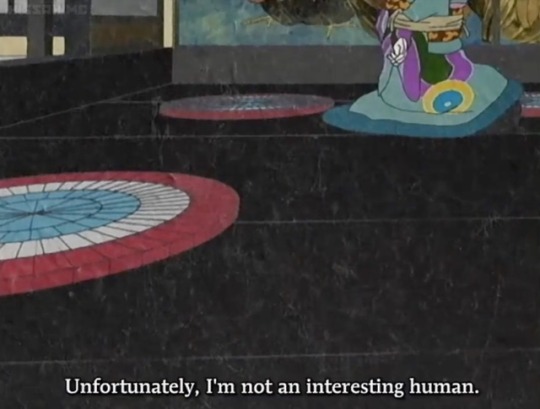
What is the Medicine Seller?
The subjectivity of Mononoke is a large part of what makes the series unique. But, one of the biggest mysteries that the show leaves unanswered is what exactly the Medicine Seller is supposed to be. From his weird powers, traits, and appearance to the fact that he clearly doesn’t age, it’s an understatement to say that this isn’t a normal guy. All kinds of theories have been floating around about the Medicine Seller’s true identity, that he’s a onmyōji, a god, or some kind of benevolent mononoke.
However, for my money, looking at all the evidence combined from the show and Japanese mythology, I’ve concluded that the Medicine Seller is most likely a kitsune.

Now, I feel like most anime viewers have at least a cursory idea what a kitsune is, but just to recap: “Kitsune” (狐) is the Japanese word for fox. Traditional Japanese folk beliefs attributed all sorts of mysterious powers to foxes, including shapeshifting, creating illusions, and warding off evil spirits. Taking cues from ancient Chinese lore about fox spirits, kitsune have captured the imagination of Japanese artists and storytellers for centuries and continue to do so in the present day.
I’m far from the first person to come up with the “Medicine Seller is a fox” theory. It’s the only theory cited on the admittedly bare-bones Mononoke Wiki, and numerous commentators and Tropers have speculated that our favorite flamboyant exorcist might be a fox in disguise. So, allow me to take some time to display all the compiled evidence as to why I think this is the most plausible theory.
Let’s start with the obvious: The guy looks like a fox.
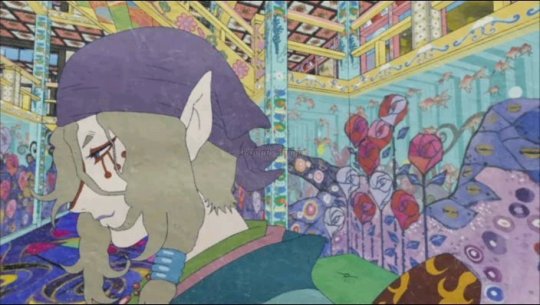
The red markings on his face are very reminiscent of the red paint you see on the traditional kitsune masks people wear around festival time. These markings are highlighted in the anime’s opening, so you can really see the similarity.

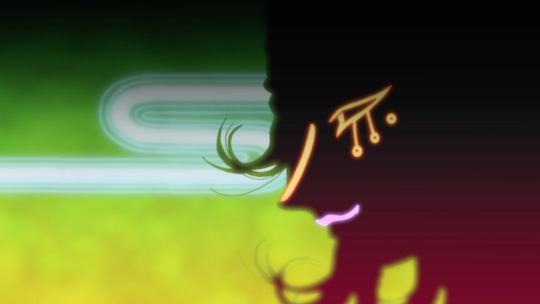
His long ears and fangs could also be considered vulpine.
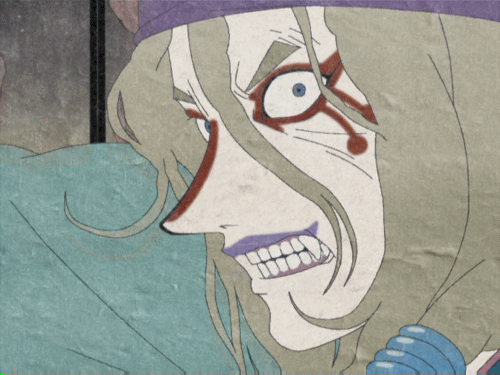
The literature is rife with examples of foxy traits showing through a kitsune’s human disguise, especially when they’re startled or caught off-guard, such as ears, a tail, or canine teeth. We’ve never seen a tail on the Medicine Seller, but who knows what he’s hiding under that robe? I’ve also seen some sources claim that the tail will be revealed if you see the kitsune’s reflection or shadow. We haven’t seen either, so who knows?
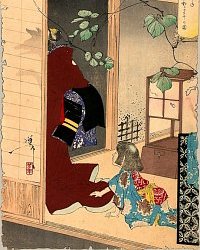
Secondly, there’s a hierarchy to keep in mind when thinking about Japanese foxes. Some kitsune are holy messengers while others are malignant spirits that bring ruin to humans. Some are merely pranksters, using their powers to pull hilarious tricks on unwitting humans, sometimes to teach them a lesson but often just for shits and giggles.
Holy, high-ranking foxes are said to be messengers of the Shinto god Inari, the rice god and the patron deity of merchants and sword smiths.
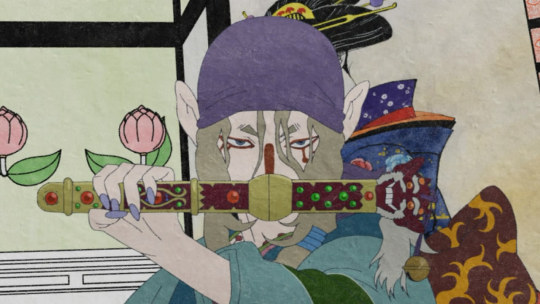
Pictured: A merchant with a sword.
Fox statues like the one pictured above can be seen standing guard in front of Inari’s shrines, where they are said to ward off evil. The A-to-Z Online Buddhist dictionary has this to say:
“[T]he fox is associated with the concept of Kimon 鬼門, literally “demon gate,” a Japanese term stemming from Chinese geomancy (Ch: feng shui). In Chinese thought, the northeast quarter is considered particularly inauspicious. It is the place where "demons gather and enter." This belief was imported by the Japanese and is referred to as Kimon. Kimon generally means ominous direction, or taboo direction. In Japan, the fox is considered a powerful ally in warding off evil Kimon influences. Fox statues are often placed in northeast locations to stand guard over demonic influence, and two foxes typically guard the entrance to Inari Shrines, one to the left and one to the right of the gate.”
He may not be a statue, but “warding off demonic influences” is basically half of the Medicine Seller’s job description. He often uses seals, salt, prayer, and other methods accessible to humans, but the Bakeneko arc of Ayakashi clearly shows he can keep a mononoke at bay just by flexing really hard.
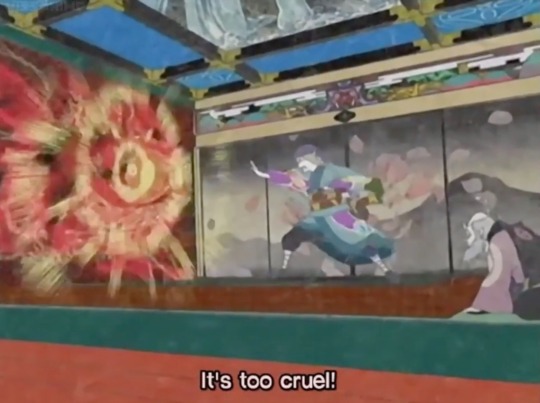
Yokai.com goes into some detail about the various ranks of kitsune, from the lowliest trickster to the most divine guardian. One rank of kitsune of particular interest to me is called the Kiko (気狐), a servant of Inari that has evolved to the point where it no longer has a physical form. Many Kiko adopt human disguises, but they have not yet ascended to a heavenly plane and so remain on Earth serving Inari’s will.
We have never seen the Medicine Seller eat, drink, or sleep. There is, however, one physical need that he does indulge in.
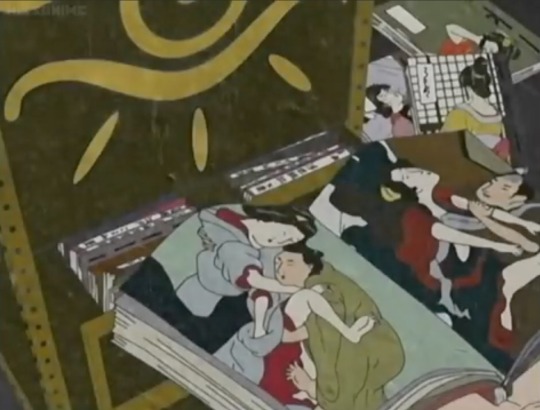
If you get my meaning.
Pictured above is the Medicine Seller’s extensive shunga (春画) collection. Shunga is Edo period porn, and it wasn’t exactly uncommon for merchants to be carrying volumes of shunga on their person. However, 20+ volumes seems a bit excessive to me.
It’s a trait that doesn’t come up all that much in Mononoke, but the first episode of Ayakashi’s Bakeneko arc reveals that the Medicine Seller is a bit of a horny bastard. He trades info on various virility and fertility medications with Kayo, a conversation that involves a lot of whispering into her ear. He was about to share his porn with Kayo before they were interrupted. I’m convinced that if Sato had entered the kitchen ten minutes later, she would have found the two of them fucking on the floor.
As anyone who's watched Naruto can tell you, kitsune are often associated with sex. Inari, among other things, is also a fertility god, and there are many stories of kitsune adopting human form and seducing unwitting mortals, running the full gambit from the horrific to the romantic. A good chunk of these stories involve the kitsune marrying their human beau and even bearing his children in some cases.
Most stories of this nature center on female kitsune, but it’s not like male kitsune don’t exist. The popularity of sexy fox women can probably be chalked up to male-dominated Edo society, but more and more male kitsune have been sighted in modern anime.


I believe we can add Mononoke to this number. Practically every woman in the series creams their pants at the mere sight of the Medicine Seller, and it doesn’t seem that their attraction is one-sided. The Medicine Seller has all kinds of sexual tension with Kayo in both series. And, if you look closely, you can spy some romantic tension with Ochou as well. There’s little doubt that the Medicine Seller is attracted to human women and is even capable of falling in love with them. However, due to his role slaying mononoke, it is unlikely that he can ever settle down and marry one the way many other kitsune do.

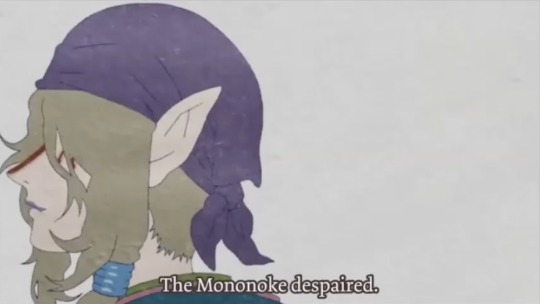
Personality-wise, the Medicine Seller is also reminiscent of a fox. Like I mentioned above, kitsune are often tricksters by nature. Although the Medicine Seller never acts in a needlessly malicious way, he does like to dick around with people. A lot of the aforementioned tension with Kayo takes the form of teasing banter.
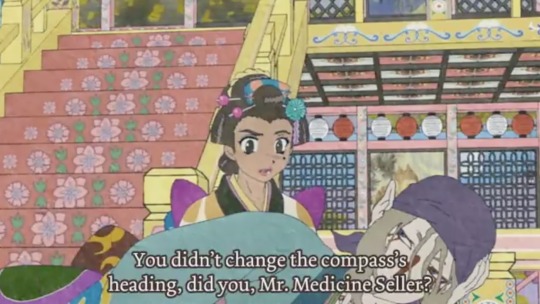


Keep in mind: It wasn’t him who changed the compass. Which means he’s being vague for no other reason except to mess with Kayo.
He also spend a good portion of his arc in Ayakashi trolling the Sakai household, especially Odajima. And do we even need to mention his gambit in the Nue arc?
youtube
So, his appearance, relationships, and personality are all decidedly fox-like. What about his powers? Well, in the Nopperabou arc, we get a pretty clear hint that the Medicine Seller’s physical form is just an illusion.

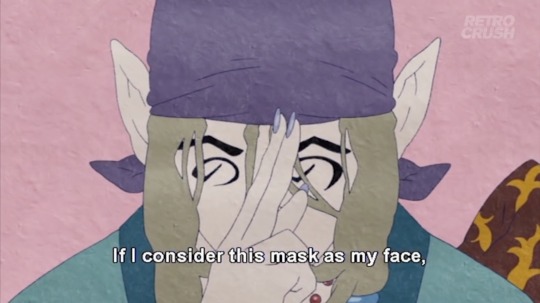
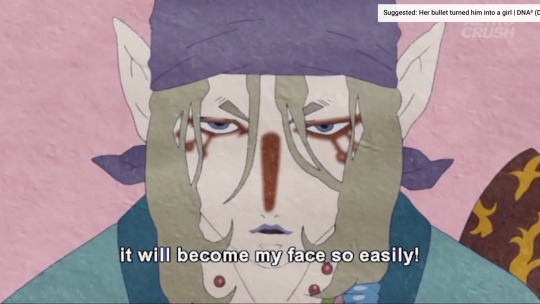
The Masked Man’s attempt to take away the Medicine Seller’s face failed because that wasn’t his real face. He outright compared his face to a facade. Since it was just an illusion, it was easy for him to change it back. It should also be noted that the Nopperabou, the faceless ghost, often appears not as an independent spirit but a hilarious prank that other yokai like to pull on humans. Tanuki, Manji (badger spirits), and, yes, even Kitsune have used the image of a faceless human being to scare humans. This is getting into fan wank territory itself, but it is entirely possible that the Medicine Seller is all too familiar with the art of face removal, having pulled that trick himself in his younger days.
That the Medicine Seller’s body isn’t real could also explain the nature of his Other Self. During his first transformation sequence in Ayakashi (which is repeated in the Nue arc), we see the markings on his face and robes disappear.
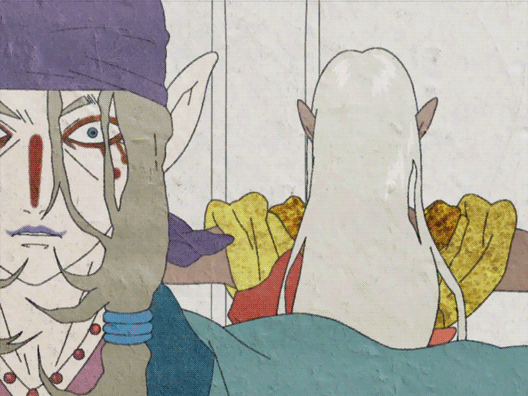
Before gold markings reappear on his Other Self.
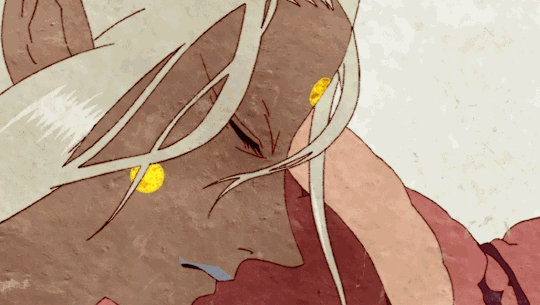
It might be possible to think of this “transformation” as more of a body surf. The flowing markings could indicate the presence of the fox spirit as it moves from one body to the other. This is a good time to point out that gold eyes are said to be another common trait of kitsune, and white fur is indicative of an Inari fox. The Other Self’s long white hair may be a hint as to his divine nature.
Now, with all his powers and religious motifs, is it possible that the Medicine Seller is not a fox but in fact Inari himself? I did briefly contemplate that possibility, but I ultimately decided it probably wasn’t true. The Medicine Seller’s powers have limits that I feel a high-ranking god like Inari wouldn’t have. It looked like he did serious damage to himself trying to hold back the bakeneko in Ayakashi.
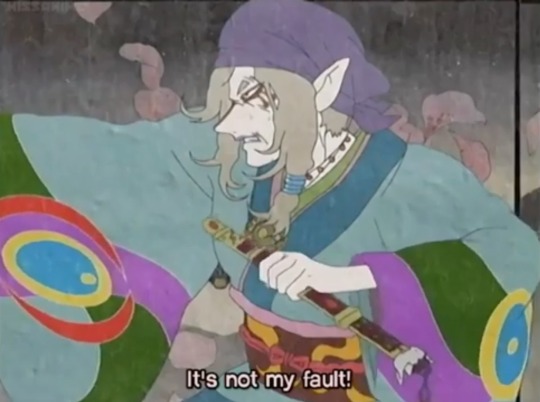

Ouchies.
Rather than being a human avatar of Inari, I find it more likely that the Medicine Seller is a kiko carrying out Inari’s will. In his first appearance in Ayakashi, some men spot the Medicine Seller standing outside the Sakai household, apparently talking to himself.
At the beginning of Mononoke’s first episode, he does the same thing outside the inn. His mouth is moving, but we don’t hear what he’s saying.
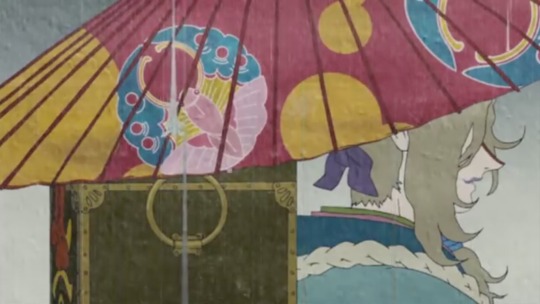
In both cases, the men who see him try to call out to him to get his attention, and in both cases he ignores them. He never says who he was talking to, and nobody ever asks. It is strange, however, that he always shows up just where a mononoke is going to be, even when he doesn’t seem to know anything about the mononoke before he arrives. Could it be he is actually receiving instructions from Inari? Inari might be telling him where to go, and the Medicine Seller figures out the rest from there. He can’t know about the mononoke’s form, truth, or reason yet, otherwise he’d be able to slay it right away. How else would he know where to go unless he was being told?
Of course, there are other possibility as to who he could be talking to. It could be his Other Self, if you hold the theory that the Medicine Seller and the Other Self are separate entities (which I don’t, so much). I also contemplated whether it was the sword he was talking to, but the sword is in the trunk. For my money, communing with a god seems the most fitting.
According to Shinto beliefs, foxes can live for up to 1000 years, which would explain why the Medicine Seller is still around after centuries have passed. But, what happens after the millennium is over? At that point, a kitsune sprouts its final, ninth tail and ascends to the heavenly plain, leaving this earth behind. I personally believe that the Medicine Seller has been tasked to wander the earth for 1000 years, slaying mononoke until his time is up. At that point, he’ll become a being as powerful as a god, but until then he must learn to truly understand humanity. Only once he has become thus enlightened will he be able to ascend.
This, I believe, is why the Sword of Exorcism can only be drawn once he’s learned the mononoke’s form, truth, and reason. He can only slay the mononoke if he comes to truly understand it and sympathize with it. It’s all part of a thousand-year long learning process in addition to aiding humanity.
And once he’s done, some day centuries from now, perhaps another young fox will take up the sword and walk through man’s despair, putting the souls of the anguished to rest.
It’s a lonely destiny, but it has its perks.
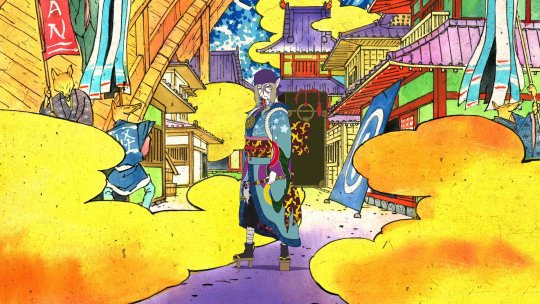
頑張ってね。
#mononoke#medicine seller#kusuriuri#theory#kitsune#fox#shinto#inari#ayakashi samurai horror tales#headcanon
643 notes
·
View notes
Text
10 Bleach Fight Scenes That Make the Anime Unforgettable
From the very first episode to the finale, fights were always Bleach's bread and butter. Whether it's the early battles against hollows or the latter fights against Arrancar, Bleach never failed to deliver a memorable showdown. Though both the anime and manga are over, Bleach has a big announcement coming up with its 20th anniversary event next month. To celebrate, we're counting down the top 10 Bleach fights that've stuck with us even after all these years!
**Watch out for spoilers and enjoy the list!**
10. Ichigo vs. Ginjo
As Bleach’s final battle, you can tell that the staff behind Ichigo vs. Ginjo gave it their all. Featuring some of the best animation in all of Bleach, it’s also a great reintroduction to Ichigo’s power as a Soul Reaper. It’s great to see him back at his former strength (and then some), after spending most of the Fullbring Arc trying to catch up to everyone else and figure out Tsukishima’s plan.
But now, with his powers returned and the other Fullbringers defeated, it’s down to him and Ginjo. Each exchange makes it clearer and clearer that Ichigo is far and away the superior fighter, and our excitement only grows with that realization. The Hell Verse soundtrack that plays during their final exchange is the cherry on top here, adding the perfect epic sound to conclude this fight. Bleach may be over now, but it certainly went out with a bang!
9. Shuhei vs. Findorr
Shuhei Hisagi was always in an odd position among Bleach’s supporting cast. He was always around, but never did much until this point. Here, though, he proves that he’s one of the coolest Lieutenants in the show. The fight starts off solid, if unremarkable compared to Bleach’s best fights, but doesn’t stay that way for long. Once Shuhei’s forced to use his shikai, it turns into nonstop momentum as Findorr tries to dodge Kazeshini and its odd angles of attack.
Kazeshini’s design makes for an interesting fighting style, and it can be hard to tell where Shuhei’s next attack is coming from. Will he use it as a melee weapon, will he throw it again, or will it loop around for another hit after his last attack? For all that he says he doesn’t like Kazeshini’s shape, Shuhei’s clearly mastered its use. He keeps both us and Findor guessing until the final blow, making this one of Bleach’s most dynamic fights.
8. Chad vs. Shunsui
Chad vs. Shunsui can barely be called a fight, but it still deserves a spot on this list for being a perfect example of how to do a one-sided fight. Chad had been built up as one of the stronger fighters in Ichigo’s group, so it’s startling to see him outmatched so quickly.
The fight plays with expectations, first showing Shunsui blocking and evading Chad’s attacks effortlessly, then setting Chad up for a comeback as he reflects on why he’s fighting in the first place. His final attack has all the marks of a finisher: large scale, obvious effort behind it, triumphant music, everything we’ve come to expect. Only, it fails. Shunsui easily avoids it and downs Chad in one blow. The shock of such a sudden ending comes with a realization: sometimes the heroes just aren't strong enough.
7. Kenpachi vs. Nnoitra
Sometimes you want a tactical battle, where each side is trying to outsmart the other. Sometimes you want to see what tricks and special abilities the fighters are concealing as they wait for just the right moment to get the upper hand. And sometimes you just want to see two tough guys hammering each other and refusing to go down. The latter is where Kenpachi vs. Nnoitra comes in. The two of them both specialize in raw power; power that’s on full display here. Even their special moves (Kenpachi’s kendo and Nnoitra’s Santa Teresa) are essentially ways to amplify their already considerable strength.
Simple as that sounds, it makes for quite a thrilling duel. Both of them are so strong that it sometimes feels like the fight comes down to who can endure the most punishment, especially once Kenpachi manages to cut Nnoitra. Part of what makes it so engrossing is how much fun Kenpachi’s having for the entire fight; it’s hard not to get caught up in his joy at facing a challenging enemy. And this isn’t even his best fight!
6. Yoruichi vs. Soi Fon
Though it’s partially overshadowed by Ichigo vs. Byakuya, Yoruichi vs. Soi Fon is a great fight in its own right. Bleach has always excelled at moments of pure cool, which is exactly how this fight starts off. Soi Fon summons a group of her underlings and seems to have the upper hand, only for Yoruichi to defeat all of them in an instant! That immediately sets the tone for the rest of the fight, which becomes a battle of speed between two masters of close combat.
Soi Fon’s Suzumebachi adds to the stakes, making every blow a risk for Yoruichi, as a second hit from Soi Fon means instant death. Bleach fights are typically built around weapons, but this fight proves it can more than handle hand to hand combat as well. With an explosive ending to top it off, Yoruichi vs. Soi Fon truly earns its place here.
5. Ichigo vs. Kenpachi
Ichigo vs. Kenpachi marks the first time we see a Captain really fight (Byakuya defeating Ichigo before doesn’t really count as a fight), and Kenpachi’s the perfect character to demonstrate why these Captains are such a big deal. Seeing even Ichigo overwhelmed by Kenpachi’s spiritual pressure hammers home that this guy is on a completely different level from everyone else Ichigo has gone against before, and that’s even before we see him stop Zangetsu with his bare hands!
Once we see just how strong Kenpachi is, the fight takes on a new dimension. It really feels like Ichigo could die here, and the tension becomes palpable as he realizes that too. It’s only by pairing his power with Zangetsu’s that Ichigo is finally able to make headway, and even then the fight is about as close as a fight can get, ending with both of them on the verge of death with everything around them reduced to rubble. Ichigo vs. Kenpachi shows us what it means to really fight, and it’s a lesson we won’t soon forget.
4. Ichigo vs. Aizen
Even though Bleach continues on afterwards, Ichigo vs. Aizen has the feel of a final battle. Everyone else is dead or incapacitated, Aizen’s goal is in reach, and Ichigo’s the only one left to stop him. With his Final Getsugatensho training complete and Aizen’s transformation continuing, the stage is set for them to finally clash, and what a fight it is. Their every exchange destroys the surrounding terrain, and even Aizen finally seems to be on the ropes. After so many episodes of Aizen dominating everyone who stands in his way, it’s gratifying to see someone finally outmatch him for once. As Aizen’s finally defeated, this fight marks the end of Bleach’s longest storyline yet, and it’s an end you won’t soon forget.
3. Ichigo vs. Grimmjow
Put simply, Ichigo vs. Grimmjow is the ultimate grudge match. The two had fought twice before, both times with Ichigo only surviving thanks to outside intervention. This time, though, there’s nobody else to interfere, and both of them are free to go all out and settle things. The raw force of Grimmjow’s Resurrección makes it clear that this is a battle for keeps, one that’s going to take everything Ichigo has.
Once the fight kicks off, it’s nonstop momentum as the two engage in a constant back and forth across the ground and air. Watching it is a thrilling experience as each hit seems like it could be lethal, with even the missed attacks destroying large chunks of the surrounding buildings. Ichigo’s finishing blow is the perfect way to end the fight, exciting and triumphant as he finally defeats Grimmjow, his biggest rival since the Arrancar first showed up. Though there are plenty of fights left before Orihime is safe, Ichigo vs. Grimmjow marks a turning point in Hueco Mundo, and is the perfect way to cap off the arc’s first half.
2. Everyone vs. Aizen
We knew Aizen was strong from the moment he revealed his true colors. After all, he was able to stop Ichigo’s bankai with just a finger! But even that didn’t prepare us for what happens when all of the remaining Captains and Vizards tried taking him down in the Fake Karakura Town Arc.
One by one he defeats these powerful fighters without breaking a sweat, all culminating in the moment he takes down Toshiro, Shinji, Shunsui, and Soi Fon in the span of a few seconds. At this point Aizen seems unstoppable, a force of nature that nobody can stand against. Though we know Ichigo is inevitably going to defeat him, at that moment, when he smiles as the Captains fall to the ground, Aizen truly seems invincible.
1. Ichigo vs. Byakuya
Out of all the fights here, Ichigo vs. Byakuya is far and away the most iconic, and for good reason. This is the culmination of everything the Soul Society Arc has been building to ever since Rukia was first taken. The stakes are clear: if Ichigo doesn’t defeat Byakuya, then Rukia’s never going to be safe, and we know that Ichigo is the only one there who can beat him. As the two engage, we learn just how far Ichigo has come, from losing without even seeing Byakuya’s attacks to fighting on even terms. Even before it kicks into gear, their relative abilities are perfectly matched, making for a thrilling back and forth.
And then the moment finally comes: Ichigo’s bankai. Few moments across Bleach’s 366 episodes are so iconic as the first time Ichigo uses Tensa Zangetsu. The fight from then on runs a gamut of emotions, from confusion at Tensa Zangetsu’s unremarkable shape compared to other Bankai to excitement at Ichigo’s crazy fast movements to shock at the emergence of Hollow Ichigo. All of that culminates in a final clash as the two fighters put everything they’ve got left into one strike. Ichigo vs. Byakuya far and away sets the standard for Bleach fights, and I can’t think of a more deserving fight for the number one spot.
What's your favorite Bleach fight? Let us know down in the comments!
Watch Bleach On Crunchyroll!
---
Skyler loves writing and chatting about anime, and is always ready to gush about the latest One Piece chapter. Read more of his work at his blog apieceofanime.com and follow him on Twitter at Videogamep3.
Do you love writing? Do you love anime? If you have an idea for a features story, pitch it to Crunchyroll Features!
3 notes
·
View notes
Text
So I saw The Last Jedi, and it was pretty great, but there’s one scene in particular that I’ve been thinking about since, and not in a good way
I think at some point during the writing/filming process Poe and Rose basically had their roles in this scene switched around (and if you’ve seen the movie you probably already have an idea of where I’m goin with this). I also think, though this would be more speculative, that this was done to avoid putting gay content in the movie.
Pretty major spoilers for large chunks of The Last Jedi under the cut please be careful mobile people. Also it was like 2 AM by the time the movie got to here so I might not be remembering it 100%. I should really watch it again before writing this but maybe if I get it in text I can shut the fuck up for a bit
So there’s a bit in the movie where the Resistance is holed up inside a base protected by a massive door (that massive door is also the only way out), and the First Order is bringing out a weapon that can laser through it. Poe leads a team out to take it on that includes Finn and Rose, and they all roll out in their little saltspeeders. They start taking losses, and Poe realizes that it’s not worth losing as many lives as are being lost. He orders the team to break off and retreat, but the weapon is already firing up. Finn decides to drive straight into the weapon and destroy it. At the last second, though, he’s interrupted by another speeder crashing into his own, which is revealed to be Rose. He asks her why, and she says something like “this is how we’ll save the galaxy. Love” and then kisses him.
Meanwhile, the First Order’s weapon fires, blasting a hole through the door. Poe is back inside having gone in through a trench with what’s left of his team. Everyone’s concerned, but eventually (I’m pretty sure it was Poe) notices that all the little crystal fox things that were in the base with them have run off, meaning that there is another way out of the base. Other stuff happens that isn’t super relevant to what I’m getting at, but it’s very close to the end of the movie, so both of these actions constitute those characters effectively reaching the ends of their arcs in this movie. The trouble I have is that Poe and Rose’s actions finish each other’s arcs, not their own.
So, let’s go into some detail in what those arcs are. (Again I’ve only seen the movie once, so I might not be 100% on this) Poe as a talented but reckless pilot who immediately puts himself in danger against orders to try and strike out against the First Order. The attack is successful, but at the avoidable cost of several lives. Leia admonishes him, and we as an audience are shown the unsustainability of Poe’s particular brand of heroism. His cavalier attitude is established as a character flaw, and the movie’s overall theme of hating enemies and loving friends not being the same thing is established in Poe as something he needs to learn.
Later, the First Order manages to chase them down and starts gradually bombarding their ships, which manage to stay just out of range of their fighters, but not enough to avoid having their shields and fuel whittled down. During the initial attack, Leia is hospitalized, so Vice Admiral Holdo, takes over command of the Resistance, and acts as a foil to Poe. She starts a plan that seems likely to fail given our (Poe’s, as he’s the viewpoint character for these parts of the movie) information of the scene, and criticizes him for things that he’s proud of, and things that have endeared him to us by this point in the franchise.
Poe, disliking Holdo and the notion of retreating, enacts his own plan to again strike at the First Order, sending Finn and Rose off to find help, then enacts a mutiny. This mutiny is ultimately stopped by Leia herself, and it’s revealed that Holdo’s plan was more sound than we knew, since the Resistance has a secret, defensible base that they plan to retreat to with cloaked ships. The focus of the retreat was to keep the Resistance members alive; gradually jettisoning their ships, and leaving them in a position where fighting back would be challenging, but at the very least, staying alive. Shortly afterwards the First Order starts firing on the transport ships carrying the Resistance, and Holdo sacrifices herself and the Resistance cruiser to stop them. This has an impact on Poe, as he comes to understand that his desire to strike at the First Order was blinding him to the possibility of other options, and the consequences of that were even more, preventable deaths.
Poe’s arc is essentially about him learning that to resist oppression is about more than just striking at the oppressor, that you also have to protect and care about the people close to you. His attitude at the start of the movie results in several deaths, and builds to the failed mutiny that puts him in direct opposition to the rest of the Resistance. It’s only after the ships are decloaked and Holdo’s sacrifice that he comes to realize that his priorities are not in order.
Rose, for her part, loses her sister at the beginning of the movie to Poe’s carelessness. When we first see her, she’s awestruck upon meeting Finn, only to become immediately disillusioned at the fact that he seems to be deserting the Resistance. The very beginning of the story is spent, for her, coming to terms with the failings of the people she’s had held up to her as heroes. Not a huge amount of time is spent on this (much like Rose’s development in general), but she gets a chance to become a hero when Poe and Finn enlist her help to go on a mission to track down a codebreaker who can get them aboard Snoke’s dreadnought.
They go to the casino planet, which Finn is not familiar with, and Rose reveals her disgust for the arms dealers and slavers that finance the city. Though this is when the movie is at it’s prequeliest, we also get to see Rose’s compassion and concern for those who can’t help themselves, specifically the animals used for racing and the kids forced into work. She, with the help of Finn, taps into that heroism that she’s been idolizing in order to act on her compassion by rescuing the kids, and the trapped animals, setting them free and striking back at their oppressors.
Rose’s arc is about her empathy for the struggles of others, and having the capacity to act on that empathy in a decisive, heroic manner. In that sense, she is the heart of the story, embodying the compassion that is encouraged in every other character. However, (maybe because she’s (unjustifiably) considered a side character) I feel like Rose doesn’t get the same learning experience that Poe / Finn / Rey / Luke do. This may be because, in (hypothetically) exchanging her role with Poe’s during the scene I’m talking about, her character development was cut short.
Rose’s role in the scene, where she crashes into Finn’s speeder to save his life, then kisses him, is not out of character, necessarily. The issues I have aren’t enough to suggest she shouldn’t be there, and that’s not what I’m trying to do;
It’s odd to me that she’s only shown to be a mechanic before this point in the movie, and is taking part in a speeder-based attack run, but there’s no reason she can’t also be a pilot
She’s just sort of added into the scene with little lead-in, but again, the movie’s already really fuckin long, I can’t blame them for skipping a scene or two like that
The relationship that Finn and Rose have been building doesn’t seem to me like one that would already be at the kissing stage, considering that they’ve known each other for like, a day, and have been pretty busy in that time, but realistically you could say the same about Finn and Poe and I sure wouldn’t be complaining about them kissing
My issues with Poe’s role are similar. As much as he’s already had a chance to mature out of his recklessness, demonstrated by calling for a retreat when the speeder mission is taking heavy losses, for him to so quickly adopt the leadership role that Leia/Holdo have been filling seems abrupt, though by no means impossible. In both cases, it’s not that the way things play out makes no sense, it’s just that there’s a few inconsistencies and issues, it’s not quite as clean.
But, by way of an exercise, let’s take the two roles, leave them structurally exactly the same, and swap the two characters. The speeder strike plays out identically, but at the moment where we reveal who saved Finn, it’s Poe instead, and Rose retreats back to the base’s interior, ultimately saving the Resistance.
Poe’s arc now concludes in much the same way, with him acting on his new understanding of the necessity of love as a tool to fight oppression. However, instead of doing so with something that just isn’t unreasonable, he does so in a way that is completely true to his character; crashing his speeder into another in a reckless, last-second charge to save someone he loves. He demonstrates the restraint he’s learned just as much by ordering the retreat, but without diminishing the passion and fire that he’s known for. Having Poe tell Finn that ‘love is how we’ll save the galaxy’ holds more weight, as it’s now Poe stating the lesson that sums up his arc through the movie.
Then there’s the obvious fact that adding LGBT rep to Star Wars would be huge, especially when it’s two of the main characters. Being bold enough to have Finn and Poe kiss at the movie’s climax would be very much in line with the core message of inspiration and hope for people dealing with oppression. I don’t think the rest of the film necessarily supports their romance as a definite conclusion, but Finn and Poe have enough scenes together that I don’t think adding the groundwork for their romance would be difficult. I think a lot of gay people, myself included, would have been absolutely thrilled to see that happen.
I also think that having Rose as the character who leads the Resistance to safety after the base’s door is destroyed makes her character arc complete in a way that it wasn’t during The Last Jedi as it stands. Rose, as I’ve mentioned, embodies the compassion and concern for others that the movie promotes heavily, and it’s this compassion that leads the Resistance to safety; by noticing the lack of crystal fox things, which have far less of an ability to fight back and defend themselves from the First Order, the Resistance comes to realize that there might be another way out of the base after all. Who better to drive that realization than Rose? Her empathy for animals was already established on the casino planet, making it more in character than it was for Poe.
More importantly than it suiting her character, though, is the fact that it completes her arc, especially as it relates to the overall story. By having Rose use the compassion that she brings to the film in order to save the Resistance, she sends a clear message that’s currently missing from the film. Not only is compassion for the oppressed a necessary component in heroism, but that compassion in itself can be heroic. Rose has the opportunity to realize that the characteristics of the people she idolizes (Finn, Poe, et al.) aren’t the only characteristics that are worthy of respect, and that she already embodies the qualities necessary to be a hero.
In the movie as it is currently, she doesn’t really get that opportunity. I feel like having her as the character that saves Finn does nothing for her, since her concern for the safety and well-being of others, Finn included, is already well-established by this point in the movie. It doesn’t demonstrate that her character has learned anything, or conclude her arc in a satisfying manner. Having her as Finn’s savior seems to mostly be for Finn’s sake, and for this scene to be the last we see of her in the movie seems like a less than ideal usage of the character. If she’s put in Poe’s place in the scene, though, she gets to grow and learn just as much as with the rest of the cast.
The reason I phrase this as a theory about the two characters having been swapped during writing/filming is that it seems extremely unlikely, to me, that a movie that is otherwise very good at ensuring its characters grow and change would falter with just two of the principal cast in this way, at the same point in the movie, especially in a manner that coincidentally would have the two characters doing things that would complete each other’s character arc. I think it’s much more plausible that Finn and Rose were swapped at some point, and even though people are starting to catch on to what I’ve said about Rose being put in a role better suited to Poe, I don’t think people are talking about the flipside of that enough. Which is a shame, because Kelly Marie Tran’s performance is fantastic - I think her character is a big part of the movie’s themes and morality, and I’d love to see more of her.
Though this is even more speculative, if I had to give a reason for why this hypothetical swap would have taken place, I would definitely say it’s due to the fact that it would be a gay onscreen kiss between two leads in a Star Wars movie. I think Rian Johnson has been receptive to - if cagey about - the notion of Finn and Poe being romantically involved. For there to be a situation where Rose and Poe were swapped, the scene would have had to be written with Finn and Poe kissing in the first place, and I think that’s something Johnson, as the sole credited writer for The Last Jedi, could conceivably write. I would then suggest that, if that’s the case, then either Johnson changed his mind / someone involved in production at Disney or LucasFilm vetoed it, too late in production for the rewrite to address the structural issues introduced by swapping the characters around, leading to the structure of the film as it is now.
I’m not much of the shipping type, and aside from obviously being hugely in favor of more LGBT content in mainstream cinema, I feel like in terms of the movie, both in itself and with The Force Awakens as context, Finn’s relationships to both Rose and Poe have, at the very least the same potential for romance. I’m not sure why Rose would get precedence over Poe, especially since it doesn’t serve the story or the development of any of the characters involved.
To add to all this, the structure of the scene makes the crash and what follows a brief moment of tension and mystery, making us unsure of who’s saved Finn. This is obviously impossible without acknowledging the possibility that it could be Poe, and I’m not sure how someone could acknowledge that, then fail to come to the conclusion that Poe would be the better choice, without an objection that wasn’t based on the story. It doesn’t affect things much either way, but the main quote from Rian Johnson on the topic of Finn and Poe being romantically involved is “In The Last Jedi, no, there wasn’t an opportunity for [LGBT+ representation]…” (from this Mashable article.) This doesn’t make a lot of sense, since it seems like there was an opportunity to have Finn and Rose be romantically involved in a scene that is specifically structured to acknowledge Finn and Poe’s romance as a possibility.
Ultimately I don’t have any distinct proof that this is what happened either way, and I think if we were to find out that the swap I’ve described happened that Disney/whoever is responsible would catch a lot of flak for it. I think it’s a shame that we came so close to having major LGBT representation in a series as iconic as Star Wars, only to have a well-developed platonic relationship awkwardly shunted into a romantic one in a way that just kinda falls flat right at the climax of the movie. The movie’s great, and Rose is a lovely character, but I think she deserves better than being denied the conclusion of her character arc for the sake of what seems to most likely be making sure homophobes are comfortable, just because she happened to be the nearest woman at the time. Maybe Rian Johnson can come through for us with a Director’s Cut that fixes this, or something
TL;DR - In the battle on the salt planet, Poe should’ve been the one who saved Finn, because his character arc was about learning that love is just as important as hating the oppressed (the line literally delivered by Rose), and Rose should’ve been the one who used her compassion for the defenseless to save the Resistance while realizing the power and importance of that compassion, and herself. It seems like the movie was originally written this way, because I don’t think it’s likely that both characters perfectly completing each others’ character arc is an accident. The most obvious motivation for doing so would be to not have gay romance in the movie.
#star wars#the last jedi#poe dameron#rose tico#finn#rian johnson#star wars spoilers#tlj spoilers#big massive star wars spoilers yall
31 notes
·
View notes
Photo

REVIEW
Absence of Mercy by S. M. Goodwin
A Lightner & Law Mystery #1
Splendid Story ~ I was hooked and could not put it down! This may be a debut novel but a stellar one for sure! With a sympathetic hero, wonderful supporting characters, history, a bit of romance, excellent plotting & writing, well, it was a riveting read!
What I liked:
* Lord Jasper Lightner: detective, war veteran, traumatic brain and other injuries from the war, son of a duke, likeable, observant, unflappable, multilingual, skilled fighter, and very human – I really like him.
* Detective Hieronymus Law: detective, falsely accused, interesting, intelligent, a man I want to know more about.
* The writing, plot, historical aspects
* Paisley: Jasper’s valet but also much more…he is a force to be reckoned with. Looking forward to hearing more about him in the future
* John: a young boy with a stammer that I hope will grow into more within the book
* Jasper’s ability to understand the best way to interact with others – no matter who they might be
* The twists and turns
* Feeling as if I was “in the story” with all senses engaged
* The canes…each one different and equally deadly…in the right hands
* Character development of main and supporting characters
* The way all the threads of the story were drawn tightly together to conclude the story
* That I thought, felt, and wondered about “what if” I had been various characters in the story
* All of it really except…
What I didn’t like:
* Jasper’s father – an unlikable man…though his wife didn’t seem much better
* The “powers that be” within New York
* The corruption of police and politicians
* being reminded of the rough life so many endure…wealthy and poor alike
Did I enjoy this book? Yes
Would I read more in this series? Definitely!
Thank you to NetGalley and Crooked Lane Books for the ARC – This is my honest review.
5 Stars

BLURB
A string of grisly murders in Pre-Civil War New York propels an unlikely pair of detectives into a deadly tinderbox in S. M. Goodwin's debut novel, a sure hit for fans of Will Thomas and C. S. Harris. Jasper Lightner is a decorated Crimean War hero and the most admired Inspector in London's Metropolitan Police. Along with a chest full of medals, he's got a head injury that's left large chunks of his memory missing. But Jasper's biggest problem is his father, the Duke of Kersey, who, enraged by a series of front-page newspaper stories extolling Jasper's exploits, decides he's had enough of the embarrassment and uses his political connections to keep his son out of the headlines--and off the police force. Jasper is sent packing to New York City on a year-long assignment to train detectives, and discovers a police department hovering on the brink of armed conflict. Assigned to investigate the murder of philanthropist and reformer Stephen Finch, Jasper joins forces with a man who might be even more of an outsider than he is: Hieronymus Law, a detective who had investigated two almost identical killings--and who is rumored to have taken money to help frame an innocent woman for murder. Law is bent on restoring his good name. But can Jasper trust Hy enough to bring him into the investigation? As the city devolves into madness and law enforcement falls into the hands of dangerous gangs, this unlikely team has no choice but to work together to pursue an adversary more sinister than either has faced alone.

AUTHOR BIO
S. M. Goodwin has worked as a bartender, college history professor, and criminal prosecutor. S.M. currently lives at 8,000 feet elevation in the Sangre de Cristo Mountains with a whole bunch of dogs, chickens, geese, ducks, and other critters. ABSENCE OF MERCY is S.M.'s first historical mystery novel.
Born
in Saskatoon, Canada
April 21, 1968
Website
https://smgoodwin.com
Twitter
smgoodwin1
Genre
Mystery, Historical Fiction, Suspense
Influences
Ian Rankin, Agatha Christie, Ken Bruen, Ngaio Marsh, Colin Dexter, P.D ...more
Member Since
February 2020
edit data
S. M. Goodwin has worked as a bartender, college history professor, and criminal prosecutor. S.M. currently lives at 8,000 feet elevation in the Sangre de Cristo Mountains with a whole bunch of dogs, chickens, geese, ducks, and other critters. ABSENCE OF MERCY is S.M.'s first historical mystery novel.
#S. M. Goodwin#Crooked Lane Books#NetGalley#Lightner & Law Mystery 1#historical fiction#mystery#murder#crime
0 notes
Text
From Spark to Flame: Predicting the End of Star Wars Rebels

In just a day the fourth and final season of Star Wars Rebels will be upon us. What began as a spark of rebellion has grown into an odyssey following the journeys of a diverse ensemble of heroes and villains spanning years, battles, generations, and a galaxy. It’s hard to believe that in less than a year’s time this series will conclude and close the book on a unique chapter of the franchise’s history and likely pave the way for the next iteration of this universe on the small screen. What should we expect in the series’ final season? In many ways, this final installment is a mystery, but because I love speculating and critiquing I’m diving in any ways. The following is my long, and I stress long, breakdown of my thoughts, opinions, and predictions going in. Who lives? Who dies? Who shacks up? Who cameos? How gratuitous will the wolves be? All here. Well kinda.
(There are potential spoilers below. Nothing not readily available to the public, but if you want to go in entirely clean, maybe stay out.)
Part I: What We Know

Something that Rebels shares with its parent series, Star Wars: The Clone Wars, is that it in many ways functions as a prequel to a large chunk of the franchise. While there are certainly climactic events and character arcs that are unique to the series, Rebels takes place in a period of the Star Wars timeline that is bookended by existing media. This has become even more apparent with the release of Rogue One in 2016. As a result, going into season four there are a few concrete facts that can help shape our expectations of how Rebels’ final season may play out.
Hera and Chopper Live
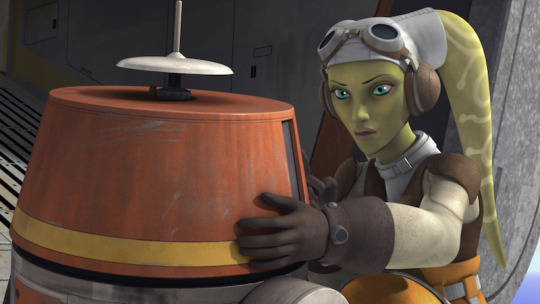
We know that the Ghost crew’s pilot, captain, and resident maternal figure, Hera Syndulla and her cantankerous droid, Chopper, are the only two members of The Ghost crew that are confirmed to survive the events of the series. Hera receives a literal shoutout line in Rogue One and Chopper has a now famous cameo in the background of the Yavin Base. This is not to say that the other members of The Ghost crew may perish, more on that later, but as of The Battle of Scarif, only two members are known for sure to be active members of the rebel alliance. We also can safely assume that at the very least Ezra Bridger and Kanan Jarrus are no longer active Force-users in the Alliance. The dialogue between Mon Mothma and Bail Organa regarding Obi-Wan strongly indicates that there are no Jedi present in the rebellion at the time of the film. Now, there are many ways that Dave Filoni and crew could cheat this, but I would bet against having Ezra and Kanan swinging lightsabers by Hera’s side by the time this season ends.
The Battle of Lothal will most likely be a loss for the Alliance

Rogue One also reaffirms a statement in the opening crawl of the original 1977 Star Wars by stressing that the Battle of Scarif and the theft of the Death Star plans is the first major military victory for the Rebel Alliance in their war against the Galactic Empire. By this logic, it is unlikely that by the time the series closes its narrative Lothal remains under the sway of the Empire. Now, it seems unlikely that the series will end in a complete downer with our heroes failing in their mission, it is possible that Lothal proves a more symbolic victory, but more on that later.
Thrawn’s TIE Defender Plan is a Failure

One of the plot threads we see shown in the final trailer for the fourth season is the internal conflict between the development of Grand Admriral Thrawn’s TIE Defender fighters and Director Orson Krennic’s Death Star. Tarkin begins to suspect that Thrawn’s pet project may not be in the Empire’s best interest moving forward given its expensive cost and lack of proven success. What is presented to us is a scenario where the TIE Defender likely has a short lived life-span with a premature death. While Star Wars has retroactively inserted vehicles, technology, and lore into the Original Trilogy period since the Prequel Trilogy, it seems confirmed here that Tharwn’s attempt to update the Imperial fighter squadron machine is fruitless.
Part II: What We’ve Been Told/Shown
In the months following the end of Star Wars Rebels season three, we have gained quite a few kernels of information from both the cast and crew of the series. Before I jump into full on speculation, I wanted to take a moment to show and extrapolate on other information we’ve gained for the series.
The season will be shorter and more serialized

One of the major complaints leveled at the second and third season of Star Wars Rebels is the focus on anthologized storytelling at times lead to episodes that seemingly did not tie back into the overarching plot or felt like diversions. Season four, intentionally or not, will somewhat address this issue. It runs shorter than the second and third season, clocking in at 16 22 minute segments, several of which form two part 44 minute episodes. Also, according to Dave, the first several episodes wrap up disparate plot threads before converging on one long story that feed into a narrative that covers the thrust of the last chunk of the season. Conventional wisdom seems to hint that we will spend much of this season on Lothal as the liberation of the planet becomes a priority for the rebellion and our cast.
Mandalore is in Civil War

Ever since Ursa Wren slayed Imperial Viceroy Gar Saxon to protect her daughter, Mandalore has broken apart with the various houses and clans vying for control of the planet with the Empire backing the remnants of Saxon’s house. This conflict takes center stage in the season premiere “Heroes of Mandalore,” which was partially screened at Celebration Orlando and then in its entirety at FanExpo. (I saw the first half myself and it’s pretty great. No spoilers, but it left me with a pretty huge cliffhanger that I’ve been anticipating the conclusion to since April.)
Rebels seems to be pulling out all the stops in putting this conflict to screen. Not only do we get a wide variety of Mandalorian characters and factions, numerous characters from this series’ past as well as The Clone Wars are due for an appearance. After teasing her return to Star Wars animation last year, Katee Sackhoff of Battlestar Galactica fame is due for a reprise of her character Bo-Katan and appears to be wielding the legendary Darksaber (perhaps Sabine hands it over to the rightful ruler of the planet?). In addition to the return of Sabine’s mother and brother, the Rebels Season Three Blu-Ray also reveals that Sabine’s father will be making his debut in the premiere. Having seen part of the episode I can confirm that he plays into Sabine’s character in a fun fashion, it’s very apparent about how his and Ursa’s personalities mixed to create their daughter. Shots of Mandalorian soldiers being turned to dust also seem to hint that the terrible weapon developed by Sabine will be deployed by the Empire.
That being said it seems unlikely that the Mandalorian conflict will spill over into the greater galactic conflict with the Empire. While Sabine and some of her close allies may take part in the battle on Lothal (Sabine can be glimpsed in the final shots of the second trailer with the rest of the Ghost Crew), the lack of Mandalorian presence in Rogue One seems to make this an unlikely possibility.
The Clones Are Back
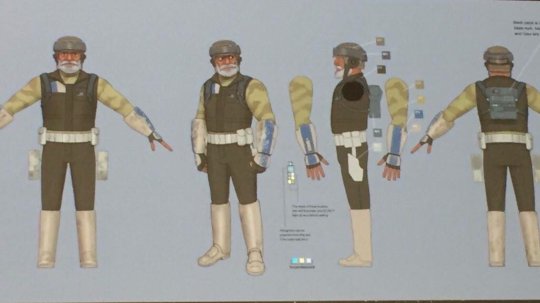
After sitting out season three, Dave Filoni and Pablo Hidalgo confirmed that clones Wolffe and Gregor would be seen on screen once again before the end of the series at Celebration Orlando earlier this year. Similarly, Dave cryptically dropped concept of Captain Rex wearing camouflage armor seemingly hinting at the popular fan theory that an older extra in Return of the Jedi may be the famous clone veteran.
Saw Gerrera and the Partisans
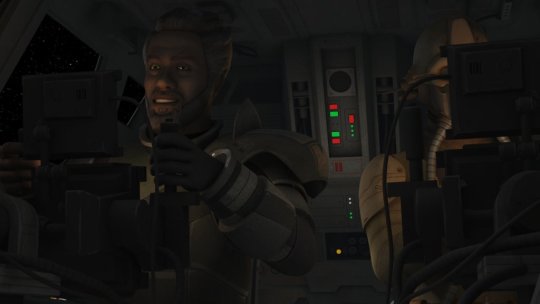
We also have been informed that Forest Whitaker will be reprising his role as Saw Gerrera in the early portions of the season. In addition to confirmation that his alien partner, Edrio Two Tubes (or maybe it’s Benthic. I honestly didn’t even know there were two of them. Did you know that?), will be joining him. The final trailer and Filoni have both hinted that this season widens the gap between Gerrera and the rest of the Alliance and may explain why he is no longer a part of the larger rebellion by the time Rogue One rolls around. He also seems set to butt heads with some key characters in the ensemble. Ezra in particular seems drawn in by Saw’s no nonsense results oriented strategy. Ezra has often been marked equally by both his compassion and his desire to see the Empire and Sith defeated. It seems likely that he will be used as a vantage point for the viewer allowing them to see both the allure and danger of a more dangerous and fanatical battle against The Empire.
Space Married

One of the most widely popular and to many the most consistently playfully frustrating aspects of the Rebels ensemble has been the frequently hinted at but never explicitly shown relationship between Hera Syndulla and Kanan Jarrus. According to clips shown at Fan Expo and the first and second trailer for this season, fans may finally get their wish and see the symbolic mother and father of The Ghost crew commit to some form of romantic relationship. Whether this has a happy ending is a whole other thing, but for a few happy moments we are more than likely to see this couple finally, maybe, kiss…or something. At least an emotional forehead touch.
Rukh

Thrawn’s Noghri bodyguard from Timothy Zahn’s classic trilogy of novels is set to make his first canon appearance this season voiced by the legendary Warwick Davis. While his role appears to have been reshuffled to be more of a special agent/assassin in Thrawn’s employ rather than the almost enslaved bodyguard in his Legends appearance, it is unclear just how much Rukh borrows from his original role. Most importantly, is he the one to place once again place the killing blow on The Empire’s blue skinned Admiral? I’m inclined to think not.
Space Wolves
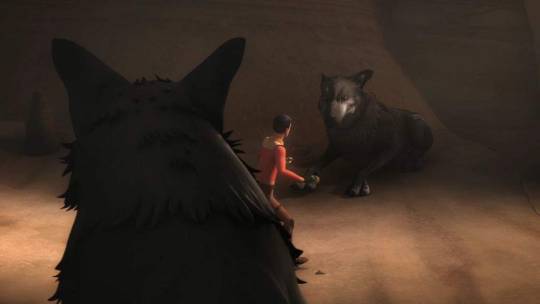
Dave Filoni loves wolves. Like, he really really likes wolves. What would the final season be without a whole lot of giant magical space wolves? The Loth-Wolves so far have remained a mystery, but their importance and almost mystical presence have been stressed throughout season four’s marketing campaign. While we can rest easy knowing that Ahsoka isn’t pulling a Sirius Black and transforming into a wolf like some fan’s speculated, Filoni has stressed that the large white predators are a Bendu-like creature that border the light and the dark. What connection do they really have to the planet of Lothal and the series as a whole? Who knows, but it will be nice to finally get a sense of how they fit into the planet’s culture.
Ahsoka Lives !(?!)
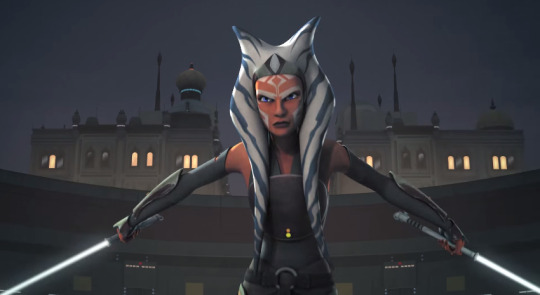
Oh yeah, Ahsoka is back. How? Why? Where? Who knows, but Dave Filoni has confirmed that we will see Ashley Eckstein’s fan favorite former-Jedi at least one more time before the series ends.
Part III: Rampant Speculation
So what does this all mean? Where are we going? Who is that? Where am I? Before I start jumping into the general end game for the series, let’s get a few more pieces of speculation out of the way. Let’s talk characters. Let’s talk deaths. Let’s talk why Nick keeps using repetition to spice up this segment of his article.
Kallus and the Rebellion

While Alexsandr Kallus (yes, that’s officially his first name now) has been a rebel operative for about a full season now, this season marks the first time that the former Imperial operative is an active participant in the Alliance. Sporting a snazzy new outfit and set to make a change in the galaxy, Kallus is sure to be one of the more intriguing aspects of this season going into its start. I highly doubt that Kallus’s assimilation into the rebellion will make for a clean transition. In particular, Kallus seems primed to be a key source of antagonism with Saw Gerrera. As we learned in “The Honorable Ones,” Saw’s partisans were responsible for the deaths of Kallus’s men on Onderon. Similarly, Saw’s own fanaticism makes it seem likely that he won’t be keen on having a former Imperial Intelligence officer enter the Alliance. The two seem primed for a confrontation and Dave Filoni and the creative team would be smart to capitalize off this. The idea of having David Oyelowo and Forest Whitaker face off is too great an opportunity to pass up.
Thrawn will survive
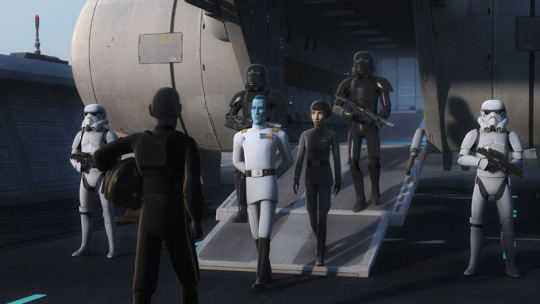
Grand Admiral Thrawn’s survival is one of the most hotly debated aspects of the series. The iconic Legends turned canon Chiss admiral has been a fan favorite on and off screen. While he more or less came out on top at the conclusion of season three, Thrawn’s fate is a bit more ambiguous this season. Like many iconic Rebels characters, he does not play a role in the original trilogy and for a character of his stature and in-universe importance, it seems unlikely that he is still an active participant in the Imperial war machine at the time the series concludes. We may have actually been given our first clue to the fate of Thrawn at New York Comic Con last weekend. Timothy Zahn, the original creator of the blue skinned villain, announced that he would be writing a sequel to his canon novel, Thrawn, tentatively titled Alliances, which would feature the character teaming up with Darth Vader himself. While this inherently may not seem like a dead giveaway that Thrawn makes it out of the series alive, the original Thrawn novel concluded just before the character’s introduction in the season three premiere episode “Steps into Shadow.” While it is possible that the sequel novel may function as a pseudo-prequel or even a mid-quel, this seems to indicate that Thrawn’s narrative continues past what is seen on screen. Similarly, the final novel in Chuck Wendig’s Aftermath trilogy appears to hint that Thrawn spent much of his later career stationed in the Unknown Regions, although the language is vague and inconclusive.
Expect Lots of Cameos

With the Ghost Crew now firmly a part of the larger rebellion, it seems inevitable that we will be seeing at the very least cameo appearances from numerous famous characters. Bail Organa, Jan Dodonna, and Mon Mothma all seem like givens for speaking roles, but I wouldn’t be surprised to see various others as well. With the continued attempts to establish creative synergy between Rebels and Rogue One, I think it is highly likely that characters such as Admiral Raddus will appear, especially given that Stephen Stanton is already a regularly employed member of the Rebels voice cast. I also wouldn’t be surprised if we got a few more notable cameos such as Cassian Andor or K-2SO. Having two Fulcrum agents such as Cassian and Kallus interact seems like another relationship that would be key to exploit. I also would be very surprised if we finished the series out without seeing Leia or Darth Vader again. Both characters made a splash in their first appearances in the series’ second season and it seems like both characters still have something to contribute to the narrative, Leia in particular.
Only one Ghost Crew member will die
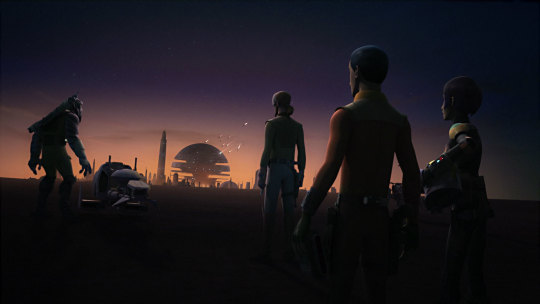
While Hera and Chopper are proved to make it out of the series, Rebels will not pull a Rogue One and end with the death of the majority of its cast. We may not know what fates may befall Ezra, Sabine, Kanan, and Zeb but a massacre seems off the table. For a simple and almost logistical reason, Rebels is a series that is at its heart tonally optimistic and targeted at a mature but younger audience. It isn’t afraid to kill characters, good or evil, this is true, but Rebels is a series that is most concerned with exploring family and the importance of standing up for a larger cause in difficult times. I do not see Dave Filoni, Lucasfilm, and especially Disney XD, sanctioning an ending for the series that reinforces such a bleak understanding of sacrifice and familial bonds. It may be a good ending, but it’s hardly the best and certainly not the route that Rebels will take. That being said, it seems just as unlikely if the entirety of the Rebels cast is to survive. Heroic sacrifice and the cost of war are a theme of Star Wars and Dave Filoni at times has been all too aware of this. I am willing to go on the record and say only one member of the Ghost Crew will perish and there are two likely candidates.
Sabine seems least likely out of the four non-confirmed survivors of the series to perish. Her fate at this point is almost more connected to the Mandalorian struggle than to the rebellion itself. While it may be a poignant end for her story to have her sacrifice her life to bring liberty to her people and reunite her family, it feels out of place and, again, overly bleak for the series to take this route for her character. Besides, with the media blitz that Sabine has received since her involvement in the Forces of Destiny toyline and animated shorts, I doubt we’ve seen the last of our graffiti inspired Mandalorian warrior.
Ezra is this series’ biggest question mark. Rebels is at the end of the day about him and his journey from street rat to Jedi apprentice to freedom fighter. Does the story end in his death? I’m inclined to think not. Why? Well, again, on a practical level, I cannot recall a single television series aimed at a preteen to teen age demographic that ended with the death of its child protagonist, even if, yes, Ezra is pushing the age boundaries for that term at this point. Rebels has to keep in mind both its adult and child viewers and killing off the hero in the hero’s journey may not be the move that best placates both audiences. That being said, in terms of canon, Ezra does create a problem. He is simply too prominent and powerful a figure to be left around in the universe by the time we reach the events of Rogue One and A New Hope. Well, where is Ezra then? I’m getting to that, I promise.
That leaves our two likely death candidates being Garazeb Orrelios and Kanan Jarrus. Zeb is the character I’ve spoken the least about in this write up and frankly there is a reason for this. While he began the series as one of the show’s more compelling and entertaining characters, season three proved just how stagnant a character the Ghost Crew’s Lasat had become. In two strong episodes in Rebels’ second season, Zeb’s character arcs had effectively resolved themselves. Zeb had not only found out that he was not the last surviving member of the Lasats, in fact there is a whole planet of them, but had also reconciled with his longtime nemesis, Agent Kallus. With Kallus now a willing member of the rebellion, this relationship also seems to have reached its natural conclusion. While there is certainly opportunity to develop this dynamic further, it almost feels as if Zeb’s purpose is to function as an extension of Kallus’s character rather than his own. Unfortunately, this makes Zeb the most dispensable and cleanest death for the Rebels team to pull off. Zeb has been with the viewer long enough for his passing to have an emotional impact both in and out of the series, while at the same time avoiding any long term damage to the series dynamics if he were to be taken off the table. Perhaps he sacrifices himself to save the Ghost Crew or Kallus? Or maybe him and Kallus go out together in a blaze of glory? It could go either way.
And then there’s Kanan. This is the hard one, because Freddie Prinze Jr.’s blind Jedi Knight and resident Ghost father figure has been not only one of the strongest characters in Rebels’ ensemble but also one of its most beloved. There is a genuine affection for Kanan. I’m sure a very large portion of the fanbase would love to see him and Hera happily settle down together and raise some Twi-Lek/Human hybrid babies (I mean we know that can happen thanks to The Clone Wars), but, man, things just don’t look good for him. Like Ezra, Kanan’s continued participation in the Alliance creates a massive problem for the larger lore of Star Wars. A practicing Jedi Knight being a participant in the Alliance would surely be noticed and would have come up in conversation, especially considering the addition of Luke Skywalker to their ranks following the Battle of Yavin. Kanan has to be removed from the playing field somehow. While it is possible he could join Ezra on my big series end theory, it is just as likely if not plausible that he becomes one with the Force. This would undoubtedly be the most emotional route the crew could take and it is a very likely possibility.
Part IV: The Ending

So how does Rebels end? How does this saga conclude in a manner that resolves its various plot points but also moves us towards an emotionally satisfying conclusion that capitalizes off the series’ themes? In all honesty, I’m taking a stab in the dark, but it’s one that I am confident in.
Lothal is the key. Not only is it central to the conflict at the series’ conclusion and is it the home at which Rebels began, but there is something about the planet that is special. Hinted at way back in “The Siege of Lothal” by Minister Tua, there is a secret reason for The Empire’s interest in Lothal as a planet. While this has become lost in the dozens of climactic events that have occurred in the seasons since, the secret for the Empire’s presence on the grassy planet has never been answered.
We know for a fact that this cannot be related to the strip mining of Lothal’s resources as Tua confirms that this isn’t the case. Similarly, Thrawn’s use of the planet as a staging ground for the development of the TIE Defender didn’t come to fruition until after he had been relocated to the planet at the start of the third season. Whatever secret lies buried beneath Lothal has been there for quite sometime and has barely if ever been touched upon.
So what is it? We do know that Lothal is a planet filled with hidden Force secrets. From the lost Jedi Temple seen in the first season to the Lothwolfs, Lothal has a rich secret Force culture. We know from the novels and comics that Emperor Palpatine has been stockpiling Force and Sith artifacts to use in outlook stations to observe some strange threat in the Unknown Regions, which is maybe probably Snoke or something . My theory is that there is some secret Force artifact, temple, or object/place of similar significance that The Empire is actively in search of located on Lothal. Dave Filoni has stressed repeatedly that this season will be delving into a great deal of stranger imagery that is not unlike some work they’ve done in The Clone Wars in the past. While he keeps it vague, it is not hard to call to mind images of the Mortis Trilogy or Yoda’s strange walkabout to learn the secrets of the afterlife.
I believe that while much of the Battle for Lothal will remain a military campaign, Ezra and likely Kanan’s story will take a swerve into the search and discovery of what this Force secret may be, and the Lothwolves are likely the first step to finding this. While we do not know enough regarding this secret to truly learn much about it as of yet, my guess is that this artifact sends Ezra to or leads him into the unknown regions and he is forced to abandon the rest of rebellion to follow his quest. Ezra leaves the rebellion war effort to focus on a task that is possibly even more important and even dangerous.
While I believe that this will occur towards the end of the series, my thinking is that perhaps the Force grants Ezra a brief glimpse into the future. He is able to see key events in the rebellion and will learn that the future, while always in motion, will lead to freedom. I suspect that this is where Rebels will show the fates of most of our cast in how they tie into the original trilogy, such as showing Captain Rex fighting on the moon of Endor. It will be vague and likely not mean much out of context to Ezra, but fans will be able to discern where and what is occurring.
With Ezra out of the picture, we end the series with him a new environment and seemingly unknown. We know for a fact that only a scant few voice actors and production supervisors have worked on the final scene of the series and that it has been top secret. I believe we end the series with a conversation between Ahsoka and Ezra. Dave has hinted for a while that we will see Ahsoka Tano again, but the nature of her reappearance has always been vague. We do know that Ahsoka disappeared into the depths of Malachor following her duel with Darth Vader. The promotional TOPS cards (shown above) released in 2016 seem to hint at this as well, even showing Lothwolves. It seems her fate lead her onto the same path that Ezra now finds himself. It ends with both eras of Star Wars animation joining forces to find a common future.
Well, that’s how I see it anyways. I may be completely wrong, but I feel confident that the end will be something at least slightly similar to this.
We will know soon enough. What are your opinions? Where and how do you think Star Wars Rebels will conclude? I would love to hear your thoughts and critiques and predictions.
#Star Wars#Star Wars Rebels#review#reviews#swr#Hera Syndulla#ezra bridger#Kanan Jarrus#Zeb#Garazeb Orrelios#Chopper#Thrawn#Grand Admiral Thrawn#Sabine Wren#Sabine#Mandalore#Timothy Zahn#Dave Filoni#Ahsoka Tano#Saw Gerrera#Alexsandr Kallus#Kallus#Agent Kallus#spoilers#potential spoilers#commentary#star wars rebels theories#Lothal#star wars rebels season 4
61 notes
·
View notes
Text
Mini Essay Time: Why Roy Mustang’s Sacrifice Matters
I always find it strange how Roy’s battle with Bradley at the end of 03 isn’t celebrated more by the fandom.
Although, TBF, it’s most likely a combination of the fandom at large preferring Brotherhood Roy, and preferring Brotherhood’s ending over the “supposedly” cynical ending of the original. And To Be Fair, if Arakawa ever gets around to writing that sequel where Roy becomes Furhur, I might actually read it.
My fangirling aside, I think that the end of Roy’s arc is a satisfying conclusion to what is otherwise a redemption arc. As opposed to Brotherhood, where Roy not only gets a chance to rebuild Ishbal, but he will most likely become Furhur when Grunman steps down.
But that does raise a very serious question here? Regardless of which version of FMA you prefer, ask yourself;
Should Roy Mustang really become Furhur of Amestris?
The answer; no. And not just because he’s a war criminal, either.
As many people have pointed out, Roy’s ultimate goal is redemption, not Furhurdom. And that makes sense, participating in mass genocide would traumatize anyone. And while I think Roy knows he can never truly atone for the atrocities he caused (which is probably why he never seeks to actually confront Winry about murdering her parents, aside from the fact that he’s afraid to do so), he’s so guilt ridden and disgusted with himself that the only thing he can do is try to move forward.
He wants so badly to redeem himself, so badly to change the country in which he lives in, that he thinks the only way to do that is to climb up the ladder and be Furhur. Because what other option does he have? He can either keep living and trying to improve himself, or he can blow his brains out, which he’s too afraid to do, anyway.
But while Roy’s goal is motivated, understandable and (in some ways) easy to root for, it’s hard not to wonder what he’s willing to do to meet those ends?
While I do subscribe to the idea that 03 Roy and Brotherhood Roy aren’t all that different character-wise, the big difference is that Brotherhood Roy is a fair and just figure. Whereas 03 Roy is more morally grey and complex than that.
He’s not above doing questionable things, like that little stunt he pulled with the Elrics and the train hijacking. Not to mention that while it’s safe to say that he took in Ed and Al in an effort to protect them from becoming military test subjects, he is still using them to make himself look good.
But all of that makes sense when you put it in context to what he’s trying to achieve.
While Ed and Roy share their similarities, the biggest difference between the two of them (in my mind) has always been this. Roy Mustang is an adult who understands the only way to change the system is to fight it from the inside because that’s how it works. Whereas Edward Elric is a child who pretending to be an adult when he doesn’t know what that even means.
And that is made perfectly clear in that car scene when Roy says;
“The ends justifies the means when it comes to achieving my ultimate goal.”
Roy knows that the system is corrupt, he knows that in order to achieve his goal he must play their game. That requires him to be underhanded and manipulative, and to look like he doesn’t care. To turn a blind eye to the atrocities the military still commits because it will be all worth it in the end, no matter how much it might bother him to do so.
But is that really the right path to take? I don’t think so, and I think Roy (within the narrative) comes to that realization by the end as well. Which is why I think him choosing not to pursue Hughes’s death was a great move story wise.
It’s great because of how multifaceted it is because on the one hand, I actually find it admirable that Roy chose to not pursue vengeance. But on the other hand, it’s also a rather underhanded moment because it is another example of Roy deliberately turning a blind eye to an atrocity in favour of (what he believes to be) the greater good.
Only he’s clearly not happy about it, something that is made more evident when we see him outside the Hughes house in Ep. 29 when Sheska confronts him. It bothers him that he’s chosen not to pursue the death of his own best friend, and because of that he can’t swallow his guilt and just go see Maes’s family. At least not until the Team Mustang episode when Riza forces his hand.
And it’s really not until Sheska goes on her whole “if you won’t investigate this than fuck it, I will!”, and Ed and Al telling him about Bradley being a Homunculous and investigating into it himself that he finally decides to take action.
This ties into one last thing I wanna get into before I conclude this mini-essay, and that’s Roy’s relationship to Bradley.
For a good chunk of the series, Roy is suspicious of Bradley, and rightfully so. Any corruption in the military can be linked directly back to its leader.
And yet, what happens when he tells Bradley of what Scar plans to do to the soldiers in Liore and Bradley decides to hold back the soldiers?
He smiles.
And what happens when Ed drops the bombshell about Bradley being a Homunculous?
He’s dumbfounded. Purely. Utterly. Dumbfounded.
And that makes sense. Just like what @calangkoh said in his/her analysis of Roy Mustang’s character, he was still complacent in the system. He knows the system is corrupt, he doesn’t want to believe it’s that corrupt.
And that does make sense; Roy wanted to be Furhur and change the country. But the system itself is corrupt!
So once Roy concludes for himself not only what the Homunculi ahem been doing, but also what Bradley is that he says “Fuck it!” and plans a coup.
Some people may view this differently, but the way I interpret Roy Mustang is that he is a good man turned anti-hero who is constantly having to take “the high road” as opposed to doing what is right, because he believes it will be justified in the end and constantly having to deal with that struggle.
That’s what’s fueling his desire to kill Bradley at the end outside of choosing to do the right thing; anger.
He’s angry at Bradley, angry at the atrocities he’s committed, angry at the system, but also angry at himself. That if he hadn’t chosen to remain blind for so long, maybe he could’ve done something, then maybe so many people wouldn’t have had to die.
So in answer to that question of whether or not Roy should be Furhur, I think he ultimately realizes that he can’t do that anymore. The system itself is corrupt, and now knowing that he can no longer keep side lining whatever conscious he has left to keep reaching for that dream.
That’s why his sacrifice means something; because he chooses to do the selfless thing. And while he isn’t rewarded for it, he is able to watch as his country changes (hopefully) for the better.
.........................................
But that’s just how I see things. Feel free to comment and let me know what you think.
#FMA 2003#03 vs. Brotherhood#Roy Mustang#Character Arcs and Why they Matter#Why giving up something in order to attain something greater is important
10 notes
·
View notes
Text
Reflecting on Fullmetal Alchemist: Brotherhood
Please click “Keep Reading” to view my concluding thoughts on Fullmetal Alchemist: Brotherhood. Unfiltered spoilers inside.
Fullmetal Alchemist: Brotherhood is, simply put, a narrative masterpiece. One of those once-in-a-decade stories. But before I sing its praises, I feel I'd best get my complaints out of the way first thing. They're all laughably petty, as far as complaints go, and I'd hate to leave this reflection off on a sour note.
1: For how important he was, I felt Alphonse's role was too small. He had a very interesting mini-arc about his identity early on, but after that, he was very passive. He took the support role in both dialogue and combat. Though, he did have what is probably the show's single biggest "fuck yeah!" moment all to himself when he turned the tables on Pride and Kimblee. I dunno, maybe I was just hoping for FMA:B to be "The Edward and Alphonse show ft. a ton of cool characters." But it was actually "The Edward show ft. Hohenheim, Alphonse, and a ton of cool characters."
2: Let's be real. Trying to dethrone God and take their place is just about as cliche an anime/JRPG plot you can get. It was a bit underwhelming, but this complaint is completely dwarfed by the fact that the whole narrative I'm about to exclaim love for is written closely around it, and the fact that the villain actually succeeded (briefly).
3: I wish that one of the show's biggest twists, the Country-Wide Transmutation Circle, wasn't revealed so early. Though the plot certainly had some out-of-nowhere reveals (that always made logical sense when they happened), most were foreshadowed or hinted at. But around episode 20, Dr. Marcoh dropped a guess about the plan to sacrifice Amestris, just... out of nowhere. Looking back, I can't help but think it would have been so much better if we first saw the Xerxes flashback story, then learned about Father's plan for Amestris. It would have been a gut-punch double threat. But by the time we did see the Xerxes story, we were well familiar with the concept. We could have been surprised at the same time as "young" Hohenheim. We could have felt that "oh shit!" feeling when we learned it was about to be repeated on a larger scale. But we didn't.
4: Lack of side character screentime. This may actually be a compliment in disguise, because I'm complaining that the characters I really loved weren't around enough! Danny Brosh, Maria Ross, Barry, Alex Armstrong, Sheska, Jean Havoc, Izumi and Sig Curtis, Ling Yao (who disappeared for a chunk of the show, and then when his body was on-screen, half the time he wasn't actually there, if you get what I'm saying)... I guess too much screentime for some of them would have made them grating or tiresome. But as trickle-fed novelties, I ended up loving the characters and just wanting more. More of everything!
5: It's understandable why this happened, as the second half of the show is incredibly grim and serious, but I found myself sorely missing the humor found in the earlier episodes. There was a new joke every minute, once. By the end of the show we were lucky to get one joke in an entire episode. Again, completely understandable, maybe even necessary. But I still missed the humor... because pretty much every joke landed for me.
Um. That's it. That's all the complaining I have in me. Literally every negative thing I feel about this legendary show. Let's get to the good stuff, shall we?
This story. This story is just... it's just mind boggling. It had the illusion that every little detail was planned out from the start. It juggled over 30 important characters and plenty more in lesser roles with breakneck pacing that never felt too rushed (outside the first three episodes). And let me tell you, I am just sitting in stunned awe as I think back about every single nuance. Every major character was admittedly fairly simple, but it is perhaps this very simplicity that makes them so understandable, likable, and sympathetic. Nearly everyone had only one character trait and a very clearly defined goal from the outset of their introduction... The beauty was seeing these various traits bounce off each other and seeing how the characters got to their goal.
This was not a story where characters changed and grew. I think this story was about how the characters fought hard not to be changed. Ed and Al were tempted to drop their morals, and they didn't. Hohenheim was tempted to hate himself, and he didn't. Winry was tempted to take a life, and she didn't. Mustang and Scar were changed-- into monsters-- and were pulled back from the abyss by their friends. It... genuinely feels like everyone was mostly the same person at the start and end of the story. And somehow, it actually all works. Though, saying this sounds a bit silly because Truth scolded Father for not changing... Oh well.
Moving from the macro to the micro, let's talk about the tiny little details. There were so many elements introduced that seemed innocuous and unimportant, but were actually extremely important. Edward's short height, the butt of many early jokes, was because his body was sustaining Alphonse's. The motion of clapping hands to form a Circle out of your body, a "gift" from God, looked like praying. Havoc's family business ending up being a munitions store. The creepy tubes beneath Central, which I didn't even think to question, ended up being the pumps that fuel the Mannequin Army. As I said, it feels like every single remote detail of this grand story was planned from the very beginning. From the small to the large, it all feels so complete. There's not a single part of me wishing something was more fleshed out (aside from wanting more screentime for my favorite characters, of course).
Indeed, I'll be fondly remembering and respecting this show's narrative and characters for a long, long time to come. It started strong, stayed strong, and though it may have slowed its pace at the start of the Briggs arc, it never faltered in its step. Best of all, it even delivered a very satisfying ending. So satisfying. So happy and perfect and sweet it almost made me diabetic.
Let's wrap things up with what's left, shall we? Thinking hard, I can't exactly recall most of the background music in the show. There were one or two standouts, but... Well, I guess none of the songs were jarring or displeasing, but all the same I can't exactly praise them. They were... serviceable. Yeah. Though, I do really like most of the OP and ED songs! They all grew on me more and more, and a few I still can't get out of my head.
Then there's the animation! My goodness, the animation! For an anime of this length, I was blown away by the effort put in to make all the important fight scenes look damn good. And damn, did they look good. This show had some stellar fight choreography, even with the more fantastical magic powers, and I won't lie when I say I immediately went back to re-watch a few fights the moment I had finished a liveblog session.
Well then. That's everything, I think.
I guess there's only one more thing I have to say.
Fullmetal Alchemist: Brotherhood has succeeded Gurren Lagann as my favorite anime of all time.
In the hopefully long-running lifespan of my blog, I expect that no show will ever top the final score I've allotted FMA:B. By averaging all scores, I calculate the final score of Fullmetal Alchemist: Brotherhood to be a stunning 9.3/10!
Experiencing this show was an absolute pleasure. But even better was taking this journey with you guys.
Thanks for reading.
#Fullmetal Alchemist Brotherhood Liveblog#Fullmetal Alchemist Brotherhood#Fullmetal Alchemist#Liveblogging#Liveblog
91 notes
·
View notes
Note
How can the size of paragraphs be used to indicate mood and flow of a scene? Does the range of the paragraph sizes have an impact on readability, and are there typically different ranges and lengths common to certain genres (like comedy, horror, romance)? I'm attempting to write my first long story, and I want to figure out how to use the format of paragraphs themselves - especially in unison with others - in order to indicate some themes and tones, but I'm not sure how to go about it.
Paragraphs break the information in a scene/ chapter up into coherent sections. A paragraph in fiction often works very similarly to the way you’ve probably been told to write paragraphs for academic papers and such: you set up a concept (topic sentence), you explore the concept (body), and you reach a conclusion.
Note: I say ‘often’ and ‘similarly’ because obviously the nature of prose fiction means that these structures often look nothing like their academic cousins. The function is the same, the form it takes is often completely different.
Also note: While many prose fiction paragraphs do the above, prose fiction also utilises paragraphs to set pace, to produce imagery, to create mood and tension, etc. Prose fiction uses both ‘proper’ paragraphs, and paragraph ‘fragments’ in order to achieve the proper aesthetic and informative effects.
We’ll use some excerpts of Virginia Woolf’s Orlando as an example, this paragraph is early in the first chapter, describing Orlando’s character. We have an introduction where he is sneaking through the grounds of his father’s estate:
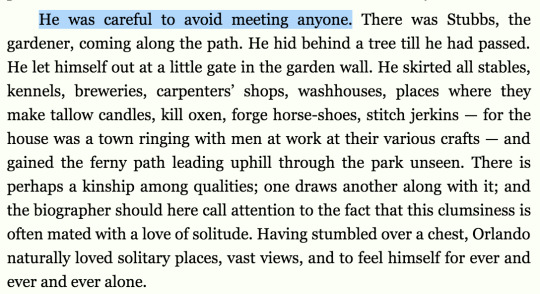
and then the body of the paragraph follows along with what Orlando does and sees while he’s sneaking:
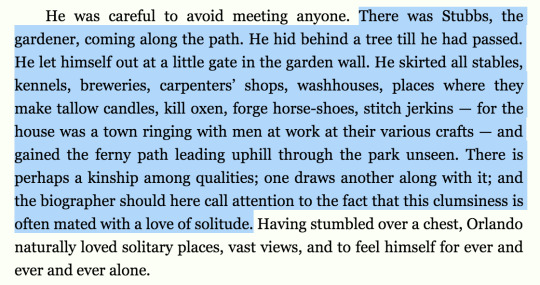
And the paragraph concludes with an observation on what this means to his character:
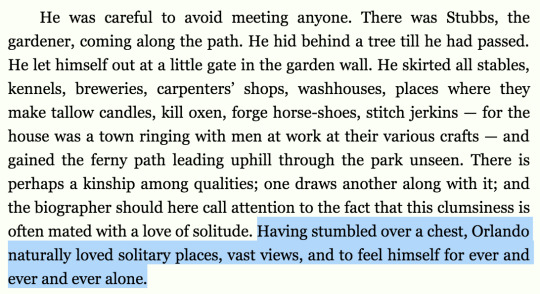
This isn’t academic writing, the exact way that these elements are utilised will change to suit the writer’s preference, but this is how a paragraph is structured. Similarly to a scene or a chapter, a paragraph should enclose an idea as a single discrete narrative arc.
(If you’ve been following this blog a while you might be noticing that writing takes on a fractal quality, when you look at it long enough, a large piece work has a similar broad structure to any small part of it -- not something you need to think about while writing, it would probably drive you up the wall, but very interesting and cool to think about)
Paragraphs break to signal a topic shift. This might be as subtle as going from talking about the weather in general (It was a dark and stormy night, and the forest around the black castle tossed and howled like the sea in a gale ...) to focusing in on how the protagonist is affected by said weather (In the top of the highest tower of the black castle, the imprisoned Prince Prism stayed tucked in the corner under the meagre blankets he’d been given, and hoped that the tower wouldn’t topple over in the wind ...) Being aware of when you shift focus or topic and beginning a new paragraph accordingly keeps your prose clear and easy to keep track of.
Paragraph breaks also indicate changes in action (paragraph 1: character a does something, there is some description, paragraph 2: character b reacts, and there is some description of that reaction).
This is also why when you’re writing dialogue it is important to make a new paragraph each time the speaker changes.
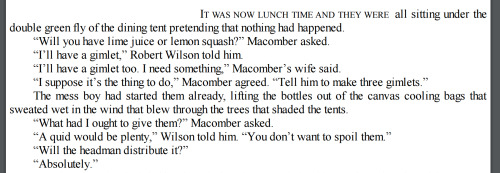
(from The Short Happy Life of Francis Macomber by Earnest Hemingway, because Orlando doesn’t have a lot in the way of conversational exchanges)
You might have found this yourself at some point, but not been able to place quite what was wrong, often I’ll read something (usually fanfic or self published: fiction editors are usually very good at sorting out this kind of issue) and find that there’s a paragraph that just goes on and on and on and I lose my place and have to go up a couple of lines and try to figure out what happened but then I can’t remember what happened at the beginning of the giant paragraph so I have to go back and start over but at that point I just close the story because I’m reading for pleasure and this is too much like work, you know?
When a paragraph goes on for too long, covers too many topics without breaking, it becomes difficult to read. Functionally, the paragraph break signals to the reader that the concept has been concluded. They can distill that paragraph down to an easily retained bit of information (Orlando likes to sneak around so he won’t be disturbed reading), and then move on to the next bit. When the paragraph doesn’t break, it’s indicating to the reader that the concept isn’t finished, and that they have to hold onto all the disparate ideas they’re being handed until the very end of the paragraph before they can distill it.
This doesn’t only happen in prose fiction, by the way, this is one of the structural areas where a lot of academic writing falls down too, because there’s so much contextual information needed that the writer keeps on going rather than breaking it up and dealing with their different points one chunk at a time. (You know those textbooks where you start reading and then halfway through a page you have no idea what you’re supposed to be getting out of it? That.)
Of course, this is not at all to say that long paragraphs are all bad. Done well, a long paragraph can assist in creating mood and pace of the story. But it must be coherent in itself, and it must have a clarity of progression through the concept that it is setting out.
Long paragraphs can create a sense of lingering over details, it can indicate a lull in action, or a calm moment. It’s also often used in setting scenes or elaborating on the internal moments of characters.
Medium sized paragraphs can also set scenes or detail internal moments, but they are more often the vehicle for propelling the action forward. Things happen, those things tell us something about the characters, setting, or situation, and we learn from them.
Paragraph fragments break up the page, used well they can make a point stand out to the reader, it’s an emphatic way to place a line on the page. Paragraph fragments can also be used to indicate that events are happening at great speed, or to create the sensation of a cascade of experiences. Action scenes often benefit from paragraph fragments, but so do moments of realisation, or emphasis.
In the following excerpt from Orlando, there is a couple of long paragraphs detailing why Orlando has become disenchanted with the people he meets and wishes to isolate himself, but also that he is conflicted in that he loves the works that people create (he loves poetry and reading) and then the final conclusions are repeated in isolation:

(the pension referred to is to retain a poet in his home to produce new works for him, even though Orlando has just realised that the poet is a scammer and has upset him pretty badly)
The first line must break because it is a new line of dialogue, but it also serves as a paragraph fragment to show Orlando’s new approach to isolating himself, he orders the servants to leave him alone and just takes a few dogs up to his rooms. But the second paragraph fragment shows the contrariness of his nature, after several paragraphs detailing how upset he is and how much he wants to be alone, he’s still paying this guy to stay.
These two fragments reveal a lot of character in just two punchy little lines. They’re cushioned in among a lot of much longer paragraphs, which makes them stand out even more. If you’ve not read Orlando, I’d really recommend it, and any of Woolf’s other work, she’s got a great approach to tone and pacing.
And changing the length of paragraphs is going to be something you learn to balance. It reminds me of this quote about writing sentences that are interesting to the eye and mind (remember what I said about fractal structural elements?)
“This sentence has five words. Here are five more words. Five-word sentences are fine. But several together become monotonous. Listen to what is happening. The writing is getting boring. The sound of it drones. It’s like a stuck record. The ear demands some variety. Now listen. I vary the sentence length, and I create music. Music. The writing sings. It has a pleasant rhythm, a lilt, a harmony. I use short sentences. And I use sentences of medium length. And sometimes, when I am certain the reader is rested, I will engage him with a sentence of considerable length, a sentence that burns with energy and builds with all the impetus of a crescendo, the roll of the drums, the crash of the cymbals–sounds that say listen to this, it is important.”
--Gary Provost
Just like sentences, you want your paragraphs to be varied. Not always wildly different, but if you tend to write longer paragraphs, you might want to mindfully utilise shorter paragraphs to break things up and lighten the load on the reader. Similarly, if you find yourself constantly writing page after page of paragraph fragments, you might want to see if you can piece some of those together or expand on the concepts you’re attempting to capture, and have some longer paragraphs in there.
Variety, balance, like so many things paragraph size and structure is something you need to work out as you go and it will change with each story. Most of the time it will probably come naturally to you because our brains are used to making stories and sharing information in the way that it is easiest to understand, but sometimes it goes wrong and you can’t put your finger on why, and it can help to have an understanding of what paragraphs are for and how you make them do what you want them to.
343 notes
·
View notes
Text
OUAT Episode Analysis- Tougher Than the Rest
Well, after a long hiatus, we finally get the conclusion to the load of malarkey that was the Wish World. And after what we were treated to in the first half of this two-partner, complete with the problematic message that Emma needed to suffer to become the woman she is now, and it was therefore a good thing that she grew up feeling unloved and unwanted, I wasn’t exactly looking forward to this one. But, people were saying it was okay, so here we go.
We open to a 7-year-old Emma, who is living on the streets of Minneapolis during the winter of 2000. It turns out her last group home was so horrible, she felt that life on the streets was preferable. To keep warm, she’s reduced to burning the pages of an old children’s book. However, she’s approached by a 17-year-old boy who waxes philosophical about the story featured in the book- The Ugly Duckling. According to this teenage boy, the story is about a duckling who became a swan because he believed in himself. He goes on to say that it’s up to Emma to decide her fate. His words apparently do the trick, because Little Girl Emma makes her way to the local police station so she can be returned to the foster system. When the receptionist asks for her name, she states her name is Emma Swan, apparently taking the name ‘Swan’ from the story of The Ugly Duckling.
So it turns out Emma chose the surname of ‘Swan’ for herself. I guess that’s alright. All this time, I just thought that she got the surname ‘Swan’ from her first family. You know, the one that returned her to the orphanage when she was three. Jennifer Morrison even said that was the case in a tweet one time. But I guess we’re just supposed to conclude actor tweets don’t count as canon. At least this way, we know the surname ‘Swan’ doesn’t have any negative memories associated with it. On the other hand, I still find it a bit problematic. I’m obviously no expert, but I’m pretty sure the courts automatically issue surnames to abandoned and unclaimed children. And Emma probably had a case file and a social worker assigned to her somewhere. Can a kid really pick and choose their own surname? But again, this is Once Upon a Time. The show where crappy squatter dens always remain vacant and available for use by the Nevengers despite no one ever paying the rent. I guess we’re just not supposed to overthink things.
Now, it’s not obvious right now, but that teenage boy is eventually revealed to have been Teenager August. And that he knew that he was talking to Emma. I get the feeling we’re supposed to think ‘wow, August was so great, ‘cause he was able to encourage Emma to believe in herself.’ However, I’m kinda wrinkling my nose at this. I can cut Young Pinocchio a bit of slack for leaving Baby Emma, because he was just a little kid at the time, and it was rather unfair of Geppetto to burden him with the hefty responsibility of guiding Baby Emma on his own. But at this point, August is a teenager. Is there really any reason why he couldn’t have just explained to Emma now that she did have parents somewhere who loved her? You know, something a little more substantial than just spouting off his personal interpretation of a bedtime story? Also, if Teenage August knew Little Girl Emma was that miserable, you’d think he’d have made more of an effort to stick with her. You know, like he was supposed to? But no, he just tells her a pretty story and then goes back to doing his own thing, leaving her to do all the work herself. Also, that story about how Emma can decide her own fate? Yeah, okay, August. Did you think about that when you conspired with Failfire to send her to jail ‘for her own good’ roughly a decade later? Seriously, August. For someone who was supposed to be her ‘guardian angel,’ you really botched it all up.
With that flashback out of the way, we return to the dumb Wish World, where Emma and Regina have missed out on their chance to get home via magic bean portal. After Wish!Robin confiscates some of their jewelry, he hurries off, leaving Emma and Regina with barely enough time to hide from Wish!Henry, who is searching for them in order to avenge Wish!Snowing and get his mother back.
Once the coast is clear, Regina voices her shock that Wish!Robin didn’t age the way Wish!Snowing did. Emma tells Regina not to worry about it, as this world isn’t real. Although, I do find the statement that the Wish World isn’t real slightly problematic. Now, if they can journey back to Storybrooke via magic bean portal, wouldn’t that mean the Wish World is a physical realm, and therefore real? But maybe this is the rules of magic just being arbitrary again. Or A&E not thinking this whole storyline through. You make the call.
Anyway, since the magic bean portal closed up, Emma and Regina are left back at square one in regards to how they’re going to get back to Storybrooke. Fortunately, Emma gets an idea by noticing a fallen tree nearby. Remembering that she was sent away from the Enchanted Forest via magic wardrobe in the actual timeline, she makes her way to see Wish!Pinocchio, who accepts Emma’s story about her and Regina being from a different reality. Unfortunately, while the magical wardrobe had been made in this universe, Wish!Pinocchio had dismantled it years prior, due to it reminding him of darker times. However, Wish!Pinocchio speculates that they can replicate the original wardrobe, as he remembers the location of the grove where the original magical tree was taken.
While Emma and Wish!Pinoccho focus on the task of making the new wardrobe, Regina decides to go off on her own. She’s starting to wonder if everyone would have been better off without her, and wants to see if Robin was better off without her, too. Gotta say, I’m genuinely surprised she’s came to this conclusion. She’s actually realizing people would have been happier if she hadn’t been around to massacre villages and rip families apart by casting the Dark Curse? (Would it be rude to say ‘well, duh?’) On the other hand, I’m wondering if this means she’s finally accepting the fact that she played a significant role in the death of Robin Prime.
Regina locates Wish!Robin in a tavern, which clears out rather quickly when people notice her presence. The only one who doesn’t seem bothered by her arrival is Wish!Robin. Regina quickly concludes that Robin was better off without her when Wish!Robin declares himself to be happy with his life, but before they could have a further discussion, they’re interrupted with the Wish World version of the Sheriff of Nottingham, who promptly captures Regina and Wish!Robin.
When they’re confined in one of those cage wagons, Regina discovers that this version of Robin never ended up with Marian, as she died before they could marry. As a result, he never became Robin Hood and was simply an ordinary thief. Once this is out in the open, Wish!Robin admits he hasn’t been genuinely happy in a long time. Their heart-to-heart is interrupted by the sudden arrival of Wish!Rumplestiltskin (accompanied by some rather horrible CGI of Wish!Sheriff being magically dragged backwards) Regina’s relief at their rescue is short-lived, as Wish!Rumpelstiskin is not exactly happy with her. Turns out, he went looking for Wish!Belle, and found her remains locked away in the tower, where she’d starved to death. (Wait, so you’re telling me that, in this version of reality, Snow and Charming, after defeating the Evil Queen, never bothered to check the cells in her prison tower? That sounds kinda odd to me.) Either way, Wish!Rumpelstilstkin decides to take his rage out on Regina and locks her and Wish!Robin up in his castle, with the intention of torturing them to death later. While they’re once again detained, Wish!Robin shows he’s intrigued by what Regina has told him, accepting the fact that, in a different reality, he turned out completely different. After a brief back-and-forth, Wish!Robin manages to unlock the cell door with a nail he took from the nearby bed, allowing them to escape.
Meanwhile, Emma and Wish!Pinocchio locate a new magical tree to create a wardrobe from. They talk for a bit about what Emma’s role as a Savior is. Although, I get the impression that Emma doesn’t really know exactly what being a Savior entails. She seems to think it’s about saving and protecting people. However, I personally think it’s about more. Just look back at Season 1. A large chunk of Emma’s role was inspiring people. Like the way she did with Ashely. And when she encouraged Ava and Nicholas’ father to take them in. Maybe 6B will actually do what the Patchwork arc promised to do by actually exploring what it means to be a Savior. Let’s all cross our fingers.
Getting back to the episode, Emma and Wish!Pinocchio are interrupted by the arrival of Wish!Killian. And yes, this version of Killian is not in a very good state, even sporting a bit of a beer gut. Okay, I suppose I should discuss my feelings about this. On the one hand, yes, I do agree this was a wasted opportunity. This version of Killian is a Killian who never managed to get his revenge on Rumpelstiltskin AND never met Emma. It was the perfect opportunity for A&E to explore how Killian would have turned out if Emma hadn’t met him and helped remind him of who he really was. Instead, they decided to play it up for laughs had have Wish!Killian be this bumbling man who doesn’t realize he’s let himself go. And I suppose it is nice to know that Colin had a ball portraying Killian like this. Besides, I’m firmly sticking to the side that says this Wish World was simply Evil Queen’s warped interpretation of reality, and what we’re seeing is essentially how she viewed Killian. It’s not actually how Killian would have ended up if the Dark Curse hadn’t been cast. Still, there’s a part of me that can’t help but admire Wish!Killian. Think about it for a minute. Wish!Killian doesn’t even know Emma, and firmly views himself as a salty pirate. How many pirates would go out of their way to rescue a princess they never met? Even if there’s reward money involved, there’s still the matter that the man’s a pirate. If he went to collect, chances are he’d be arrested on the spot. Meaning he wouldn’t get to see the reward money, anyway. And yet, despite this, Wish!Killian still seemed determined to come to Emma’s rescue. Even in this warped version of reality, Killian still possesses his courage and determination, not to mention the uncanny ability to locate Emma. (The entire royal guard of this Wish World is out looking for her. But it’s Wish!Killian who locates her.)
Anyway, Wish!Killian attempts to duel with Wish!Pinocchio, but Emma, not wanting to see this version of Killian hurt, magically knocks him out and transports him back to the Jolly Roger. And yes, she makes a comment about how she’s going to see to it that her version of Killian cuts back on the rum and sweets. I suppose you can interpret this in multiple ways. On the one hand, you could take it as Emma knowing that her Killian would be horrified if he saw himself end up like this, and so she wants to help him avoid a possible future when he wouldn’t be living a healthy lifestyle. On the other, you have to ask yourself. Would it be funny if Killian made a comment about Emma cutting back on the bear claws and hot cocoa if he came across a version of Emma that was a bit overweight? Then again, A&E don’t generally think their jokes through very well.
Unfortunately, in the struggle with Wish!Killian, the chisel that could help them carve out a new magic wardrobe gets broken, and Wish!Pinocchio can’t fix it. This leads to Wish!Pinocchio to go off feeling sorry for himself, stating he could never live up to his father’s example, leaving Emma to try to carve the tree with the broken chisel on her own. As she struggles with the task, she chances across a wooden box in Wish!Pinocchio’s toolbox. Seeing the box has her name on it, she opens it to fins a wooden swan carving inside. When she questions Wish!Pinocchio about it, he explains he always liked swans, and how they reminded him of a story his father used to tell him. Anyway, listening to his response enables Emma to figure out that August/Pinocchio was that teenage boy she encountered in the opening flashback. I’m not going to comment on that, as I already ranted about that in the start of this analysis. Regardless, Emma tells Wish!Pinocchio to take his advice and start believing in himself and his ability change his fate. And so, Wish!Pinocchio is able to successfully carve the new wardrobe.
Once the wardrobe is done, Regina returns, with Wish!Robin in tow. Regina announces the time to leave is now, as a lot of people are after them. As Regina starts to bid Wish!Robin goodbye, he gives her a fletching feather, so she’d have a piece of Robin with her. Regina instantly remembers how Roland had entrusted a fletching feather from Robin Prime to Zelena, with the intent that it be given to Regina, and that the fletching feather had been lost before she could get it. Emma speculates that, somehow, a portion of Robin Prime’s soul ended up in Wish!Robin. Which is kinda iffy logic, but whatever. In any event, Emma suggests that Regina bring Wish!Robin with them. Funny thing is, the whole reason why Emma grew up alone was because the Magic Wardrobe could only hold two people. But then again, Wish!Pinocchio did say this tree was growing for an additional 28 years, so the magic within this wardrobe is probably stronger. Which I suppose is as good an explanation as we’re gonna get. Anyway, Emma, Regina and Wish!Robin venture through the wardrobe. But at first, it looks like Wish!Robin didn’t make it through. Emma grants Regina’s request to have a moment alone, and she goes off to rejoin her family. However, once Emma is gone, Wish!Robin appears, much to Regina’s relief.
Now, the question is, did the Wish World vanish when Emma, Regina and Wish!Robin left it? The fact that they can travel from that world to Storybrooke through Magic Bean Portal and Magic Wardrobe suggests it’s an actual realm. Which would mean it probably still exists. In which case, we’ve left a world at the mercy of an angry Rumpelstiltskin. Not to mention left Wish!Henry completely alone, without his grandparents or a mother. Can we get some definite answers, please?
As for the Outlaw Queen angle, I’m not sure how I feel about this turn of events. Now, I had no problems with Outlaw Queen. I actually low-key shipped it myself. But while it is nice to see Sean back again, this isn’t Robin Prime. This is A Robin. I know they’re saying he has a bit of Robin Prime’s soul, which is why he didn’t age in Wish World, but that’s just a theory. And considering no one seems to be able to decide if the Wish World was real or not, it’s gonna be hard to give much weight to that theory. Either way, this isn’t the same Robin that Regina was led to via pixie dust. And, in the unlikely event that Roland returns to Storybrooke, how’s he gonna feel about Wish!Robin? This man isn’t his father. He’s just someone who looks like him. I’m really on the fence about this whole thing. Was this really the best way A&E could think of to bring Robin back? Why couldn’t they just go talk to Phillip and Aurora? Seeing as they figured out a way to get Phillip’s soul back from the wraith, they should be experts on recovering lost souls. At the very least, they could have discovered Robin Prime’s soul was trapped in the Olympian Crystal. Introducing a Robin clone into the mix just doesn’t seem like the best choice to me. But that’s what they’re going with, so I guess we’re going to have to live with it.
While all this was going on, Charming and Killian were searching for the Hooded Figure, who they know is in town because of Grumpy being the town’s biggest yenta. Killian, noticing that Charming is getting very high strung over the matter, voices his concern. Charming admits he feels responsible for the Hooded Figure’s presence, as he made the wish that Evil Queen got what she deserved. Charming believes that the wish is what summoned the Hooded Figure to Storybrooke. Killian does his best to console Charming by assuring him that he’ll stand by him. We then cut to Rumple and Belle, who are being confronted by Adult Gideon, who states he was raised by the Black Fairy in a place where time moves differently. Gideon’s ultimate plan, it appears, is to kill Emma. Because he believes that killing her will enable him to become the next savior.
Okay. Hold the bus a second. Gideon, I’m pretty sure the Savior mantle isn’t passed on like that. You’re thinking of the Dark One mantle. I mean, just think about it, guy. How does committing murder make you qualified to be a Savior? You know, since murder is generally considered to be a dark act. And from what we’ve seen, the role of Savior is typically tied to the ability to wield Light Magic. This shouldn’t be rocket science. I know you say that the land where you were taken needs a Savior in order to free itself from the Black Fairy’s clutches or whatever. But wouldn’t the logical conclusion be to, I don’t know, ask Emma for help? Hate to tell you, Gideon, but I think your Stiltskin genes are showing. That’s the only explanation that could exist for you actually believing killing someone would instantly make you a hero.
Regardless, we get a scene where Gold tries to talk sense into Gideon, but that doesn’t really accomplish anything. Although, Gold does accept some responsibility for Gideon’s predicament, stating he wasn’t able to protect him from the Black Fairy. But he neglects to acknowledge the fact that none of this would have happened if he hadn’t tried to corner Belle with the intention of using the sheers on her baby. If he had just left Belle alone like she’d wanted, she wouldn’t have felt the need to send Baby Gideon to safety. In the end, Gideon teleports off, refusing to accept Gold’s help. (On a side note, I couldn’t help but notice Gold claimed he knew how it feels to grow up miserable. Right, miserable. Being raised by two loving adoptive mommies and stuffing your face with meat pies sounds like a horrible tragedy. Not nearly as glamorous as living on the street at the age of seven and being shuffled from group home to group home before being sent to jail for a crime you didn’t commit and giving birth in jail to a child you were practically forced to give up. Yeah, Rumple definitely had the worst childhood.) Meanwhile, Belle seeks out Charming and Killian to tell them the Hooded Figure is Gideon. She asks them to help her find him, hoping that she can reason with her son. Charming and Killian agree to her terms, saying they’ll let her try to talk to Gideon before doing anything rash.
It’s at this point that Emma makes it back to Storybrooke, where she’s confronted by Gideon. Instantly she realizes this is her vision come to life. And she’s even brought the sword that’s supposed to kill her back from the Wish World. In the blink of an eye, the fated duel begins, with Charming, Killian and Henry appearing just as Gideon gains possession of the fated sword. Also joining them are Regina, Wish!Robin, Belle and Gold. Gideon magically freezes everyone before they can interfere, leaving him and Emma the only ones mobile. But much to Gideon’s surprise, Emma decides to choose her own fate, and her magic returns, allowing her to shove him backward, changing the vision in the process. The fated sword also shatters, allowing Emma to take one of the shards. But as she holds it to Gideon’s throat, Gold begs her to stop, as this is his son. (Which is kinda ironic, considering he did try to kill Henry on more than one occasion. Not that anyone is going to acknowledge that.) Gideon insists he doesn’t need Gold’s help, and teleports away, with everyone unfreezing.
As Gold and Belle both leave, Charming, Killian and Henry all have a joyous reunion with Emma, as well as express their amazement at the presence of Wish!Robin. Emma and Regina give a hurried explanation of the Wish World, with Killian expressing confusion over the veiled reference to his Wish World counterpart. And again, the whole ‘switching to water’ thing from Emma can easily be taken the wrong way, but I’m choosing to view it as a call-back to Killian’s line in ‘Heartless.’ “Oh, I knew it. Never trusted the stuff. Rum would never do that.”
Later on, Emma visits August to thank him for helping her out as a kid. (Yeah, thank you, August, for doing the bare minimum instead of stepping up to the plate and actually sticking with Emma and telling her about how she had a family that loved her somewhere. You know, so she would know her parents didn’t just throw her out. And can we discuss the whole jail thing? Seriously, you didn’t think she belonged on the streets, but jail was perfectly acceptable? How’s that for warped logic?) As for Belle and Gold, they have a moment by the wishing well, discussing Gideon and how they could go about helping him. At one point, I think they had Gold acknowledging that he was wrong for trying to come at Belle with the sheers, but it wasn’t very clear. And the site I use for episode transcripts hasn’t posted the transcript for this episode yet, so I can’t examine the dialogue too closely. Regardless, I really don’t care about Rumbelle at present. But it sounds like they’re going to be using this whole thing with Gideon as a way to bring Gold and Belle back together. I know this is just a goofy mid-budget fantasy show, but is this really a good message? Saying that non-stop lies and abuse can be overlooked and instantly forgiven when the wellbeing of a child enters the equation? Just saying, a couple staying together solely for the child is rarely a good, healthy decision.
So that was the start of 6B, which currently doesn’t have a name. But who knows, maybe this will be the arc that actually explores the whole Savior mythos. We’ll see.
(Click here to read more Episode Analyses)
#ouat episode analysis#ouat 6x11#6.11 tougher than the rest#tougher than the rest#emma swan#regina mills#slightly anti regina#wish!robin#wish!Pinocchio#wish!hook#wish world#prince charming#david nolan#killian jones#mr gold#belle french#anti rumpelstiltskin#anti mr gold#anti rumbelle#gideon gold#august booth#anti august
3 notes
·
View notes